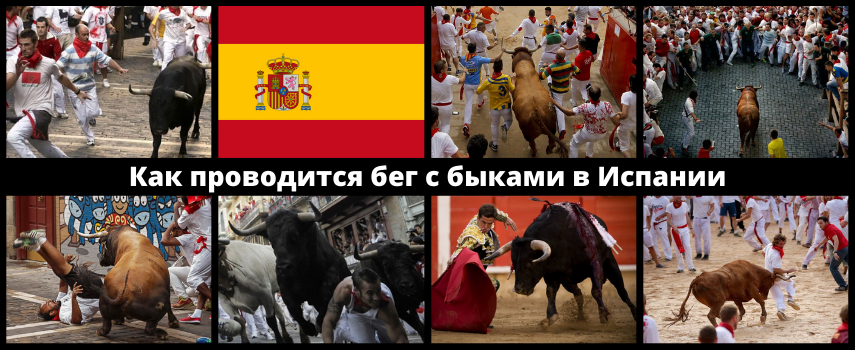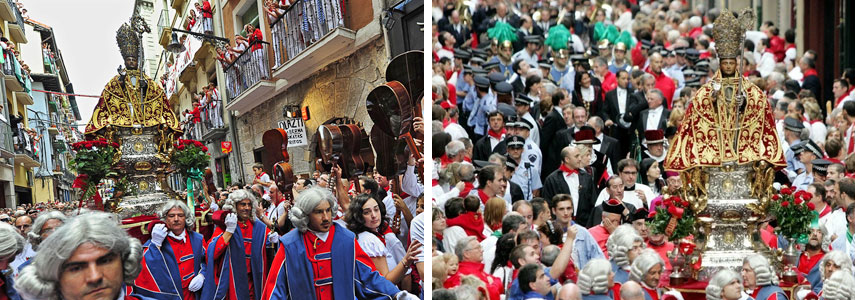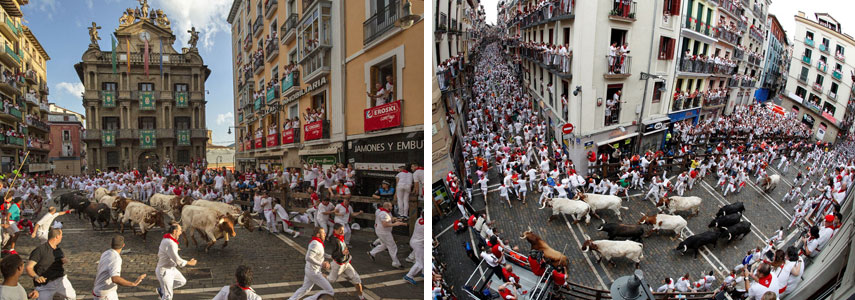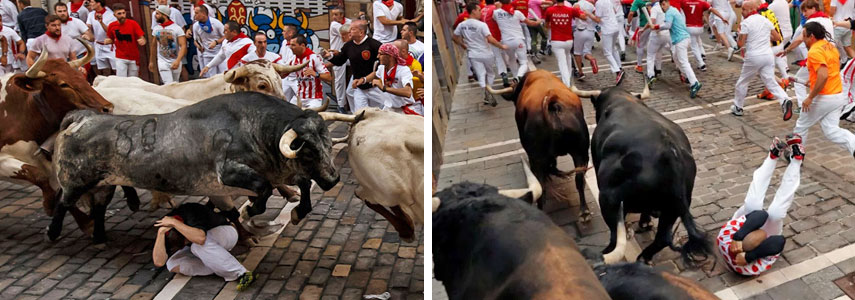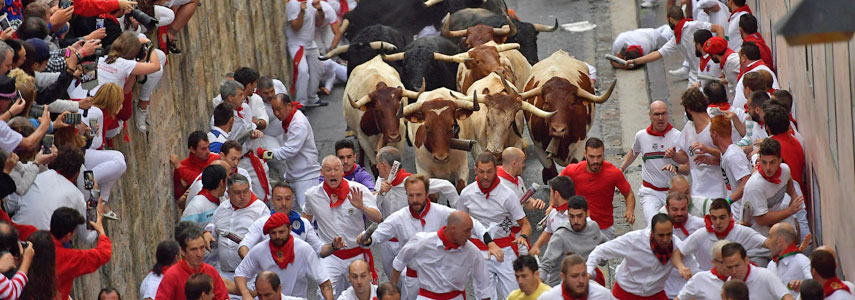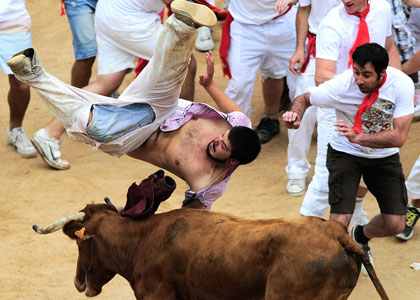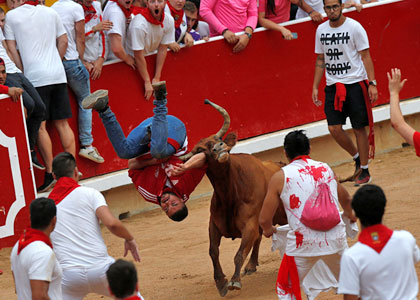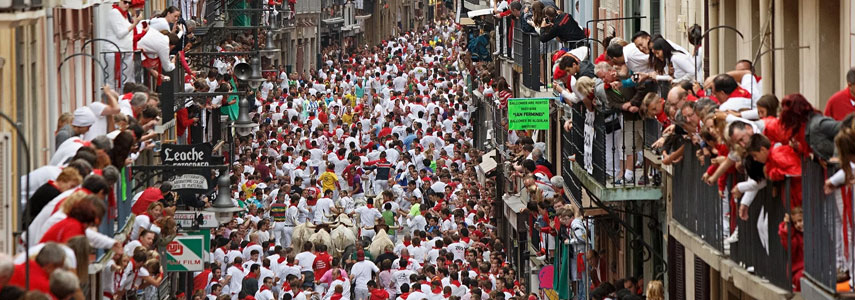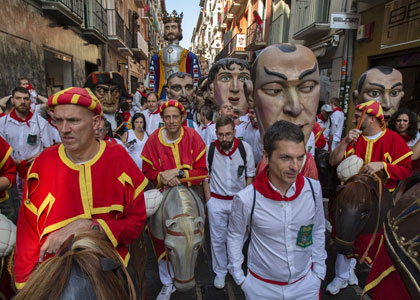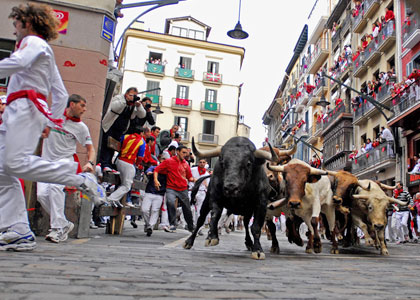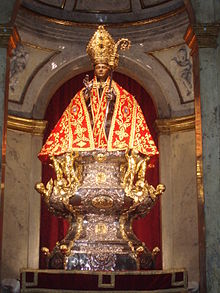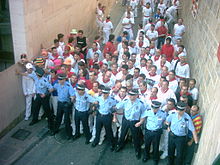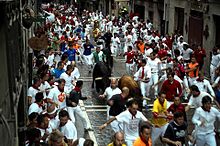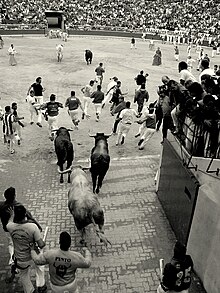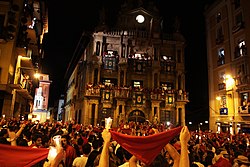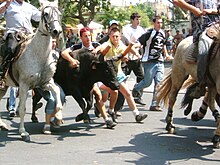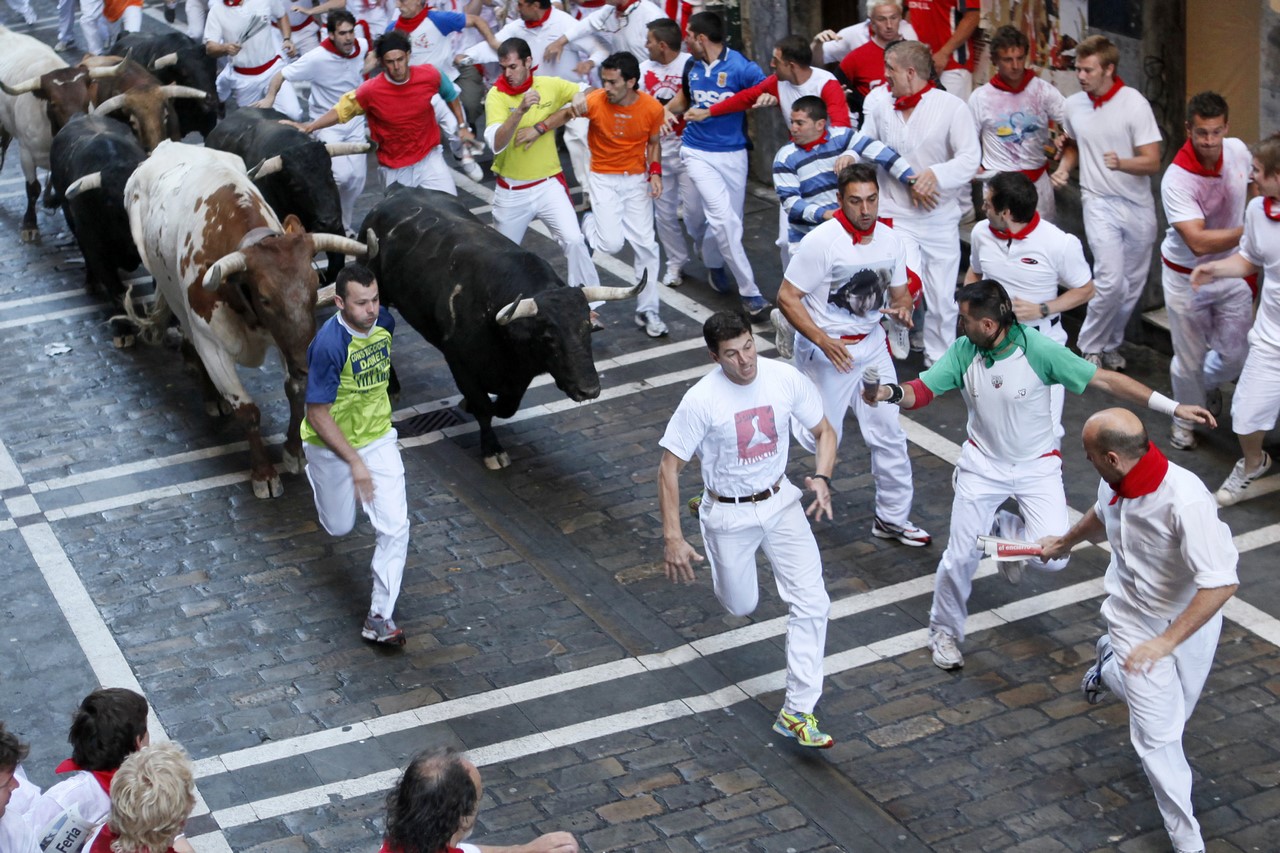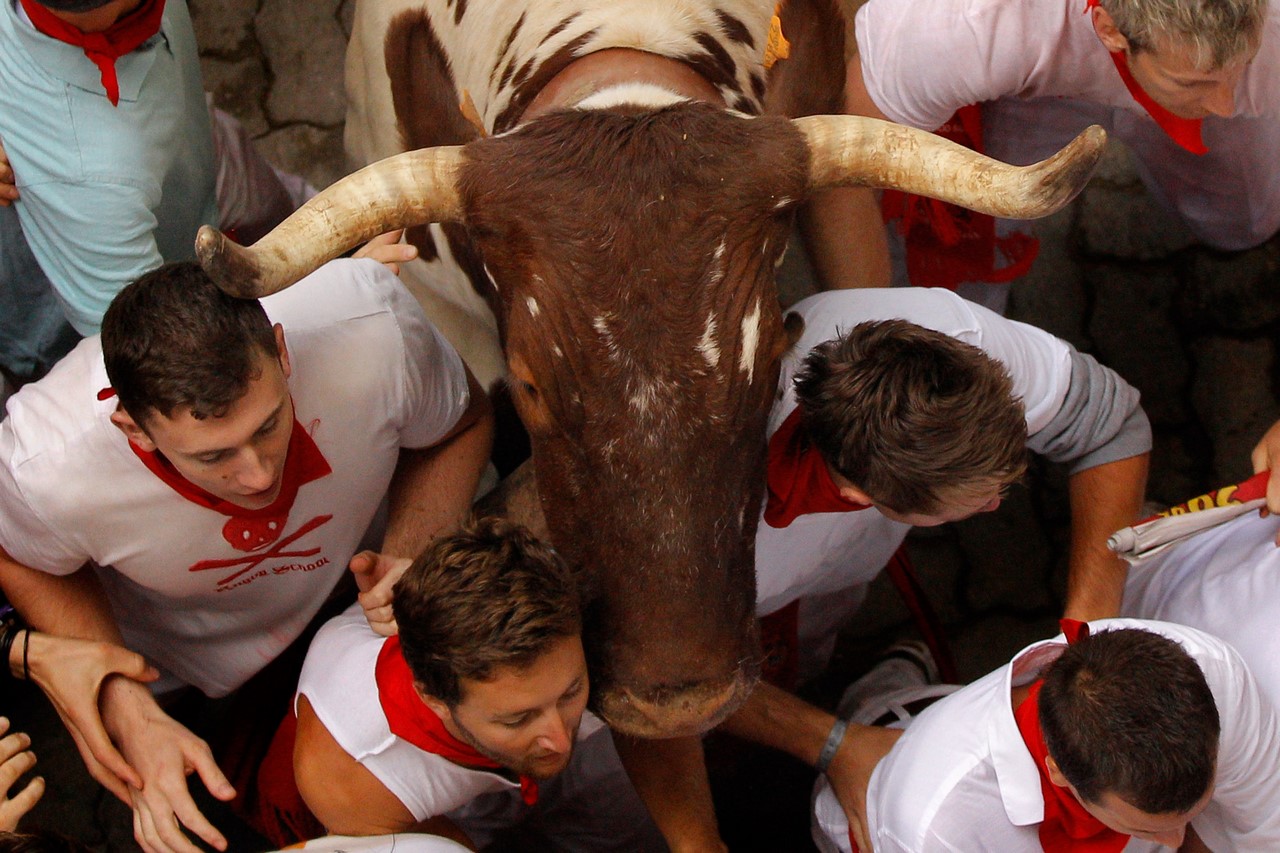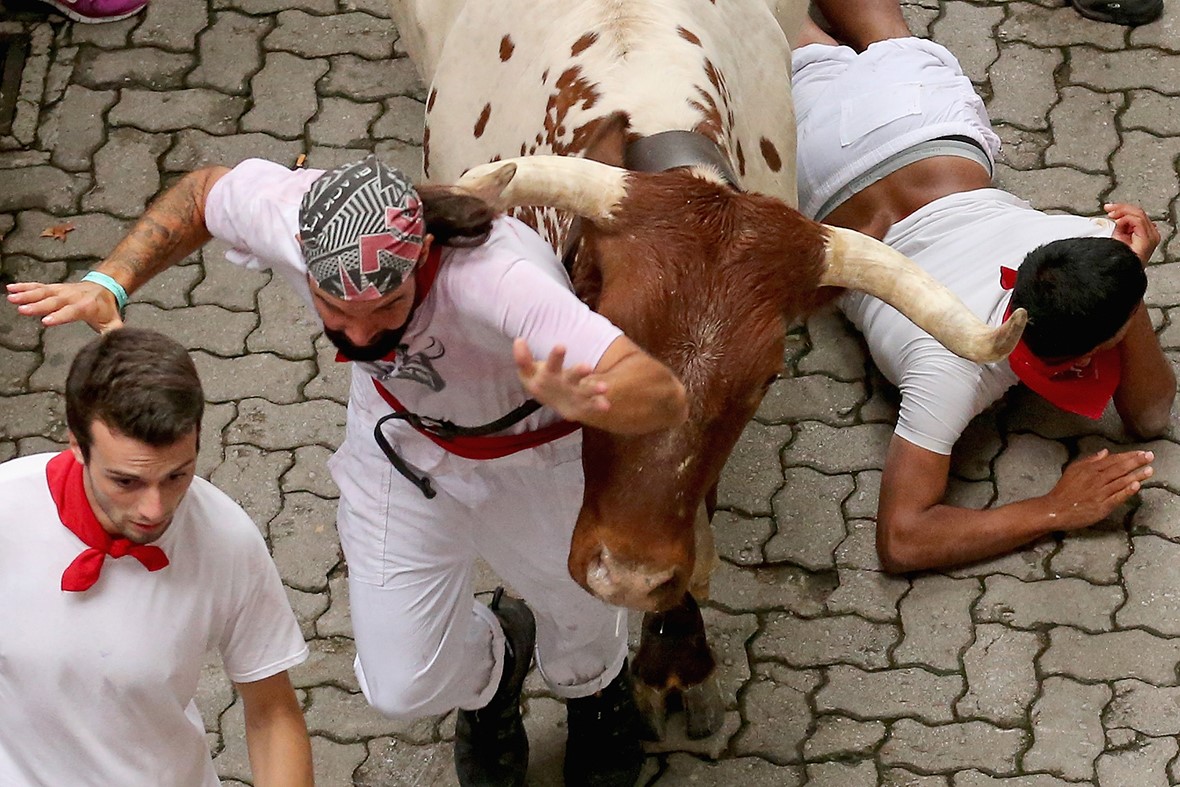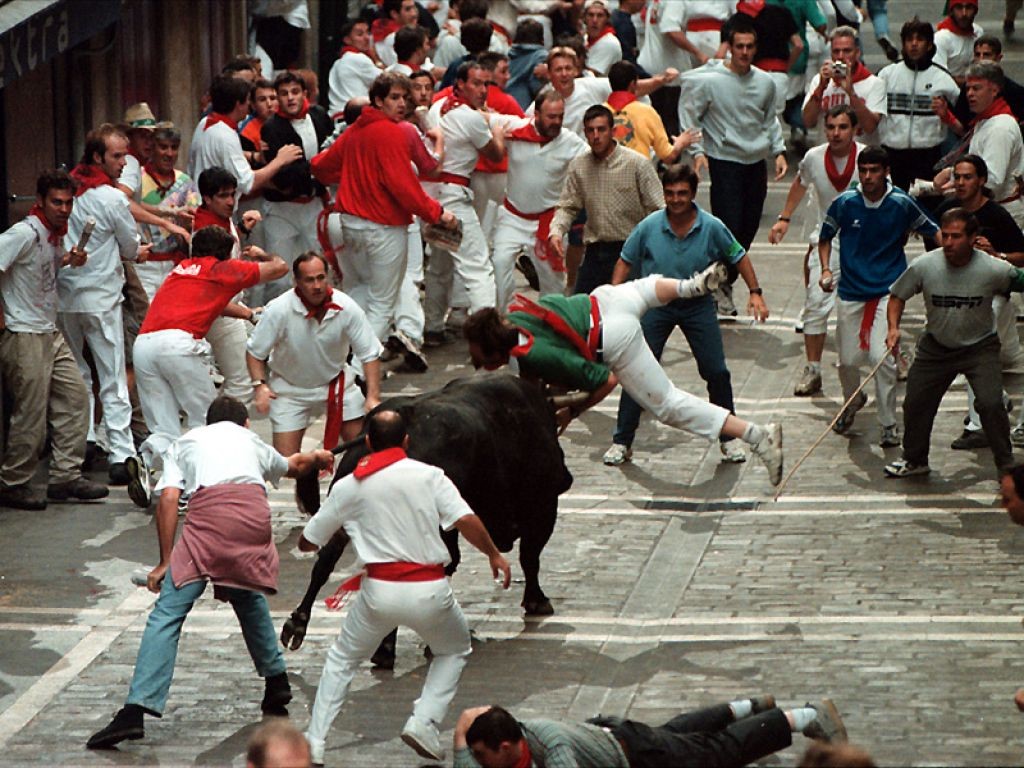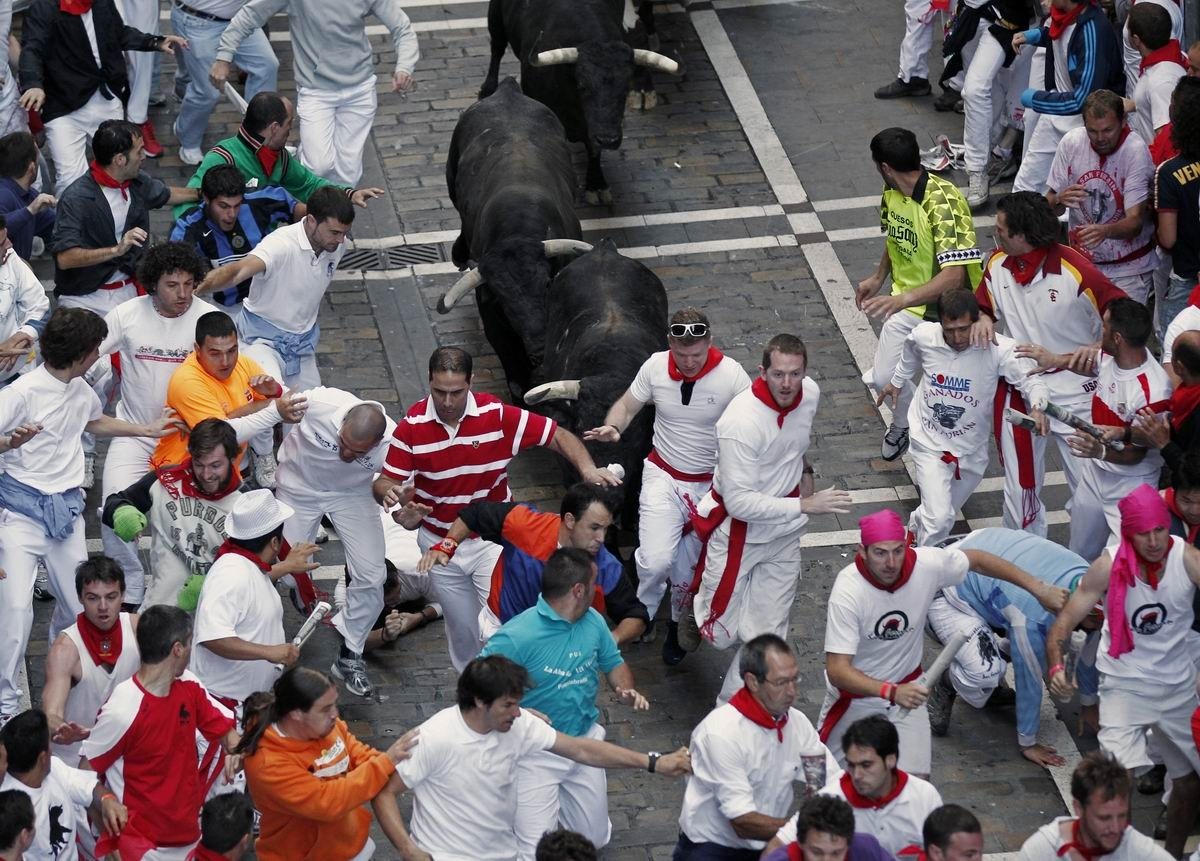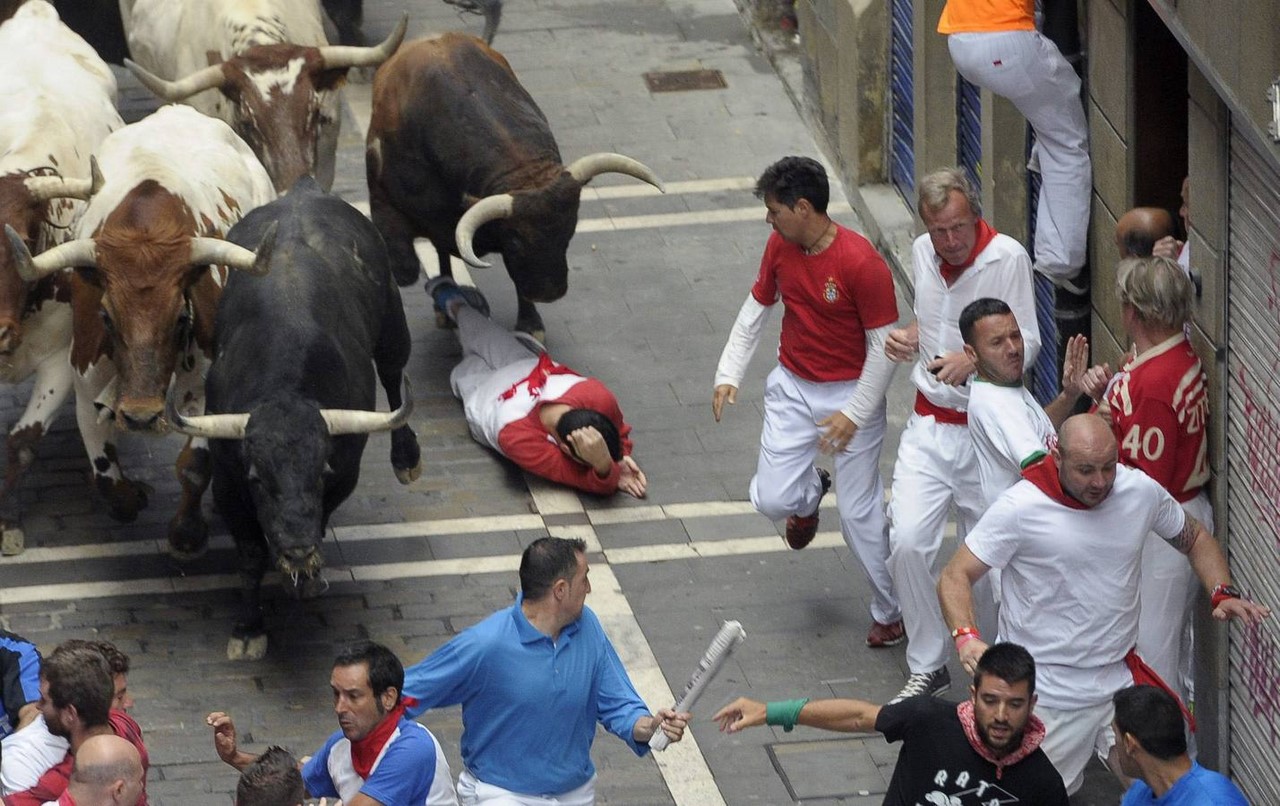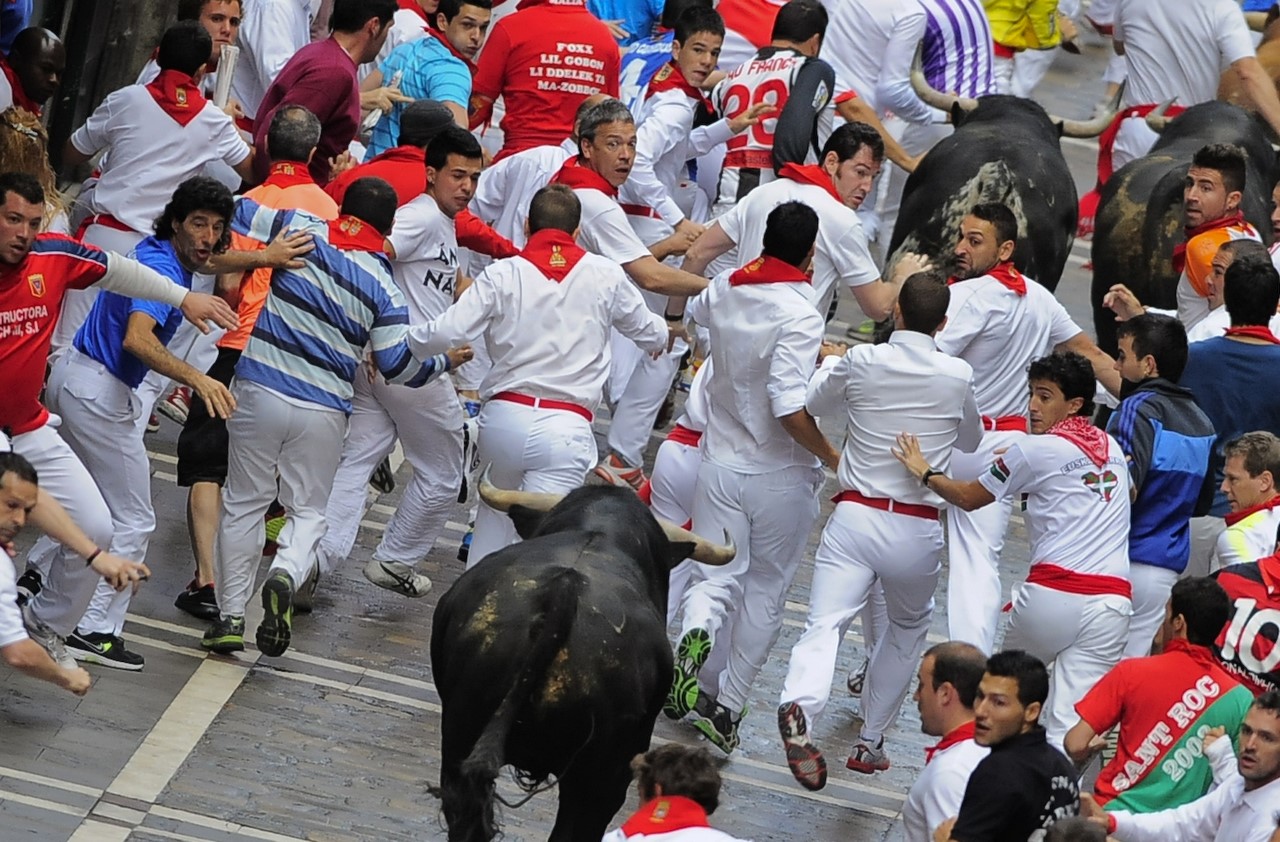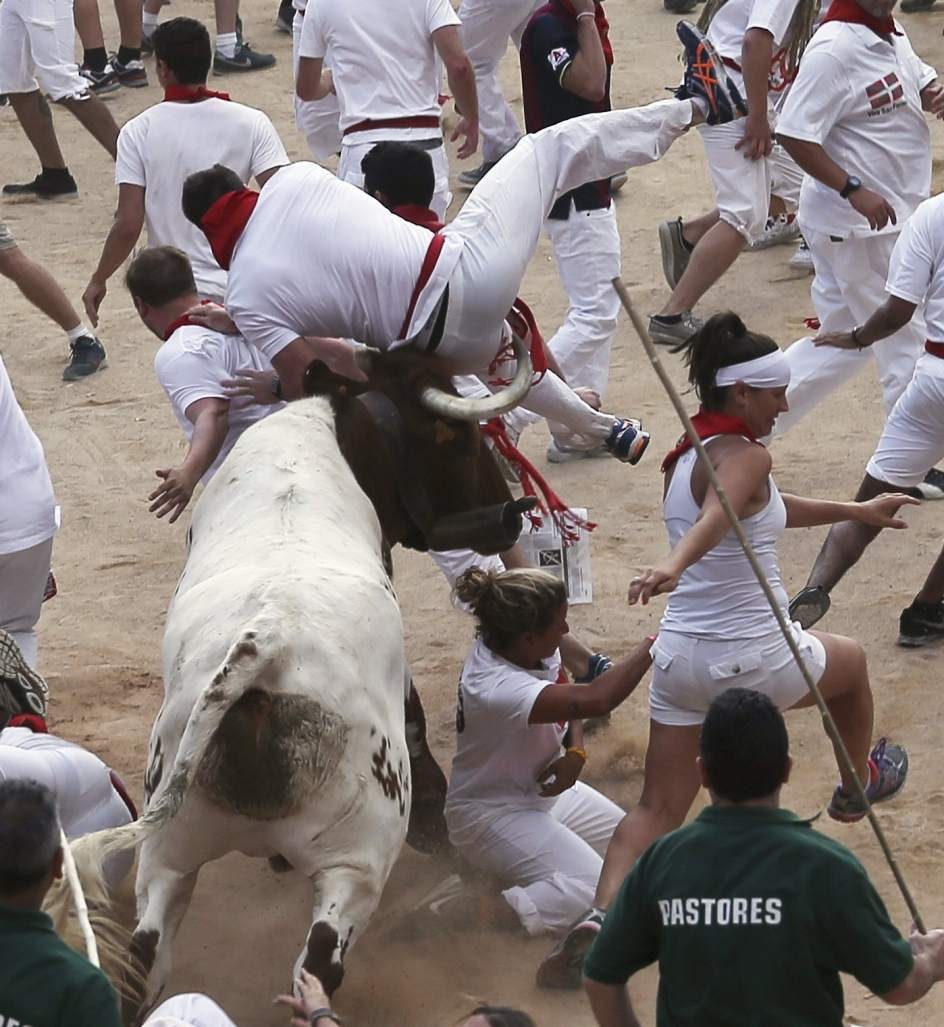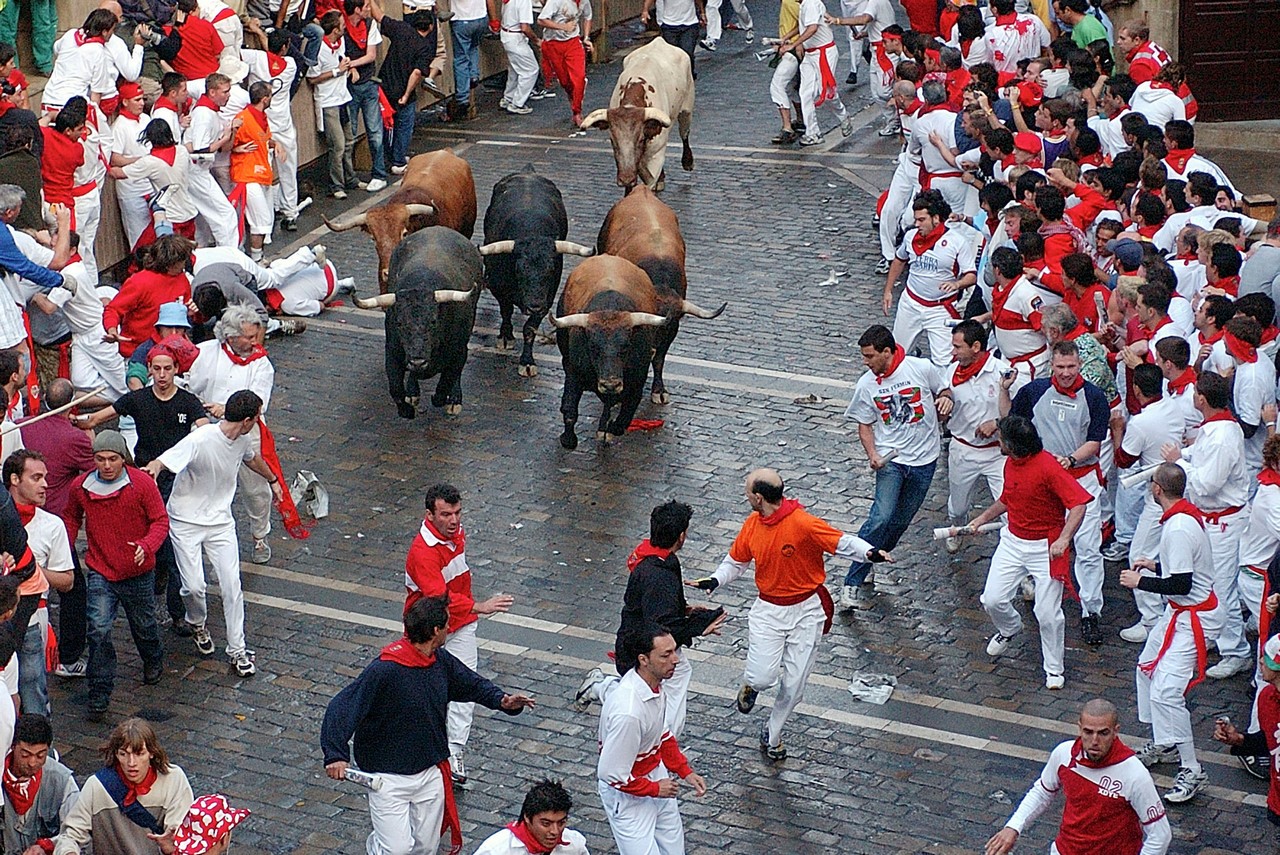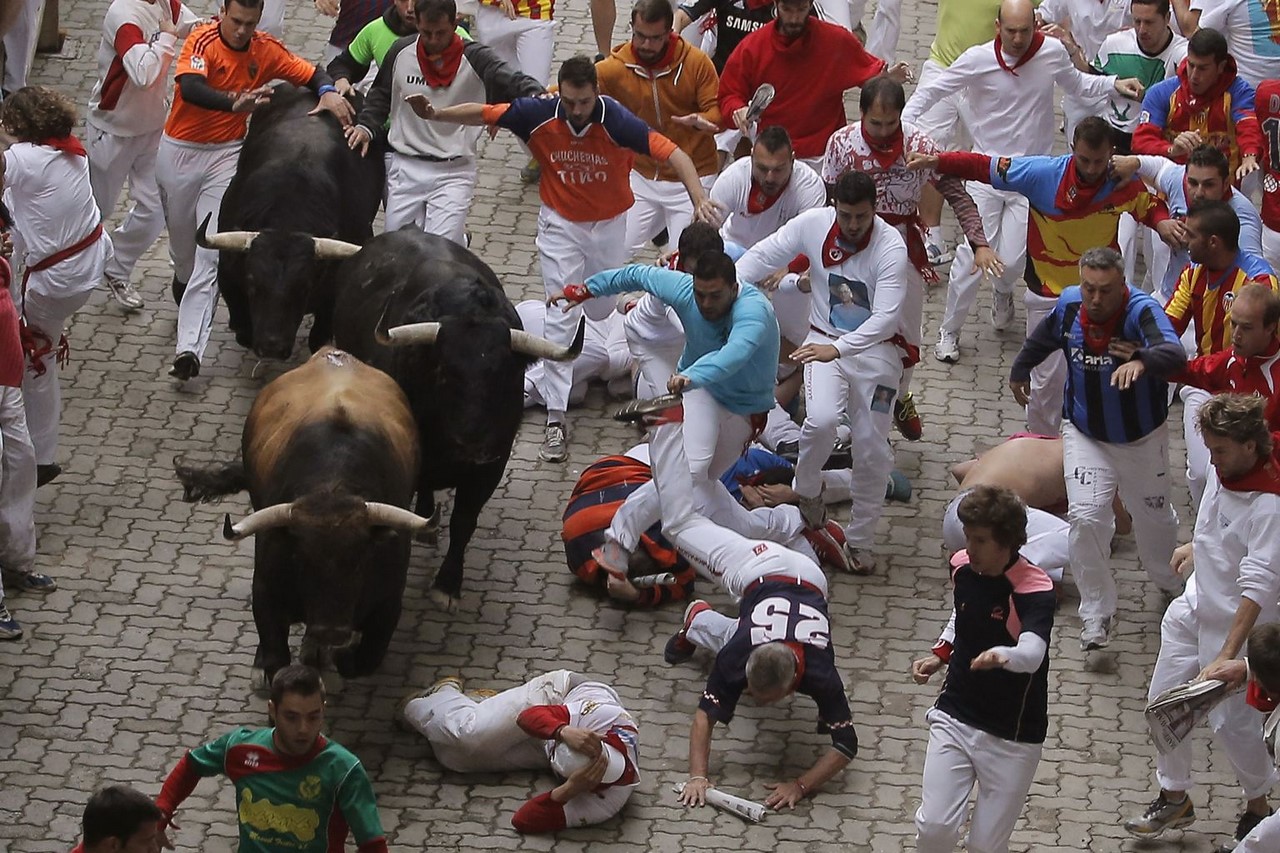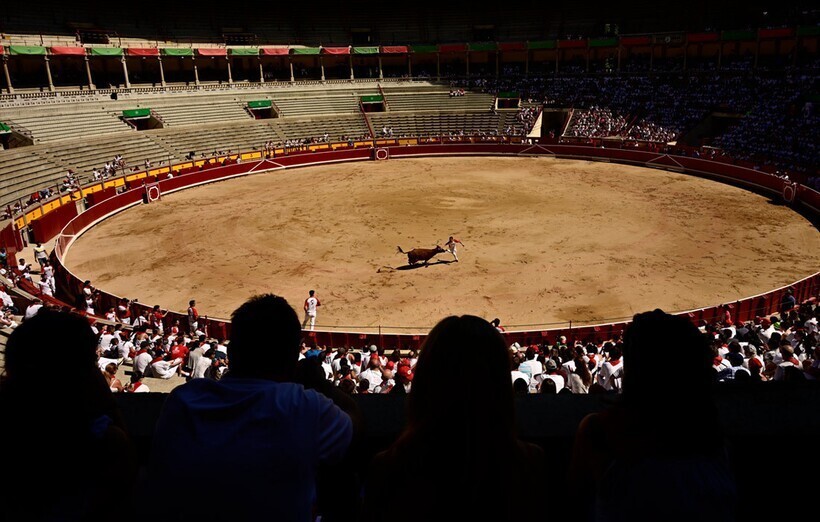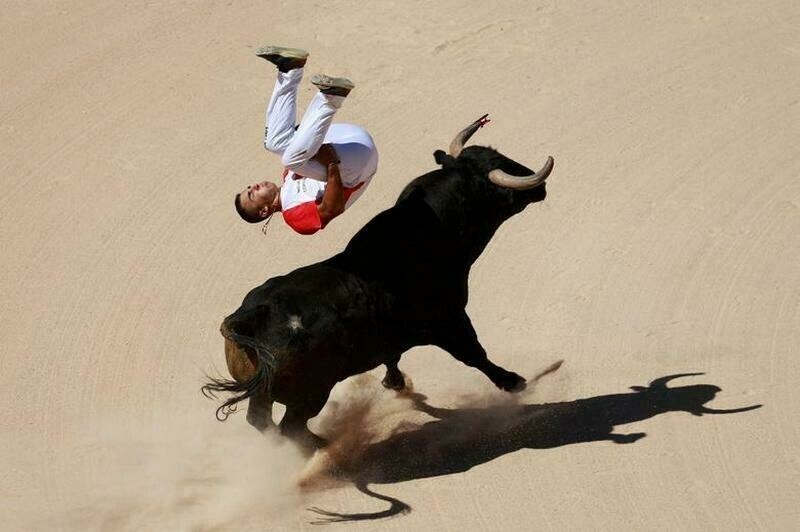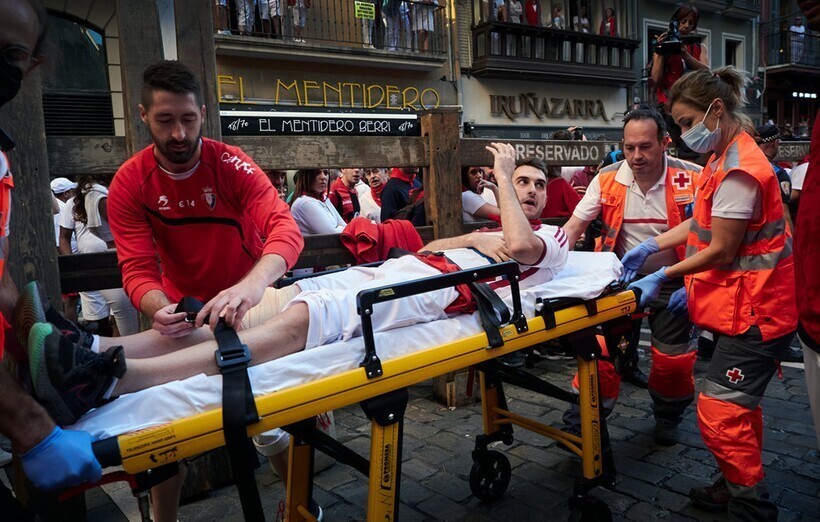Каждый год тысячи любителей острых ощущений со всего мира приезжают в город Памплона на севере Испании, чтобы принять участие в празднике Сан Фермин, во время которого проводятся «энсьерро» — совместные пробеги быков и людей.
В этом году забег имел протяженность 849 метров и продолжался две с половиной минуты. Шесть крепких быков пробежали по улицам Памплоны, чтобы оказаться на арене. Четверо человек получили легкие ранения и были госпитализированы.
39 фото

Во время бегов быков, каждый год не обходится без ранений. С 1924 года в Памплоне в общей сложности таким образом погибло 15 человек. Последний случай произошел в 2009 году. Те же, кто не желает рисковать могут в безопасности наблюдать за «энсьерро» за специальными заграждениями.
Это турист из Чили с фотографией, на котором запечатлен момент нападения быка на него в 2010 году. Тогда во время «энсьерро» он чуть не погиб, но в этом году в бегах с быками собирается участвовать вновь. (Фото Eloy Alonso | Reuters):

Сан Фермин — праздник в испанском городе Памплона, который начинается в канун для святого Фермина и длится неделю. Праздник сопровождается обильными возлияниями различного алкоголя (особенно популярного в Испании фруктового вина «Сангрия»), танцами и прочими атрибутами веселья. (Фото Alvaro Barrientos | AP):

Название вина «Сангрия» переводится как «кровь», и в Памплоне это приобретает буквальный смысл: в последние дни праздника на улицу выгоняют стадо быков, которое мчится мимо туристов, сметая все на своем пути.
Такие традиционные красные шарфы, поднятые вверх, означают начало фестиваля Сан Фермин, Памплона, 6 июля 2011. (Фото Ivan Aguinaga | AP):

(Фото Pedro Armestre | AFP | Getty Images):

Главная площадь Памплоны, 6 июля 2011. (Denis Doyle | Getty Images):

Во время фестиваля проводятся не только «энсьерро» — совместные пробеги быков и людей, но и корриды, концерты, конкурсы, детские утренники, ярмарки с аттракционами и фейерверками. (Фото Getty Images):

Все отрываются по полной. С балконов на людей льют воду, Памплона, Испания, 6 июля 2011. (Фото Alvaro Barrientos | AP):

Главная площадь Памплоны, 6 июля 2011. (Фото Daniel Ochoa de Olza | AP):

Вино в прямом смысле льется рекой, 6 июля 2011. (Фото Pedro Armestre | AFP | Getty Images):

Интересный ракурс прыжка в фонтан, 6 июля 2011. (Фото Susana Vera | Reuters):

Чучело быка и фейерверки. (Фото Alvaro Barrientos | AP):

Некоторые получают травмы. Этого мужчину подбросили на руках в воздух и не поймали, 6 июля 2011. (Фото Ivan Aguinaga | Reuters):

Особо «отдохнувшие» вином спят прямо на улицах, Памплона, 7 июля 2011. (Фото Pedro Armestre | AFP):

7 июля 2011 – первый день бегов быков «энсьерро». К одному из отелей Памплоны выносят чучела быка. (Фото Alvaro Barrientos | Reuters):

Парочка. (Фото Daniel Ochoa de Olza | Reuters):

Началось. Это «энсьерро», Памплона, 7 июля 2011. (Фото Daniel Ochoa de Olza | Reuters):

Менее экстремальные наблюдают за происходящим с балконов, Памплона, 7 июля 2011. (Фото Alvaro Barrientos | Reuters):

Сложно придумать более экстремальные развлечение, чем совместные бега с 6-ю огромными быками, 7 июля 2011. (Фото Eloy Alonso | Reuters):

Памплона, Испания, 8 июля 2011. (Фото Alvaro Barrientos | AP):

Конечно, такое мероприятие притягивает большое количество фотографов. (Фото Alvaro Barrientos | AP):

Быки бегут на большой скорости и иногда падают на поворотах, Памплона, Испания, 8 июля 2011. (Фото Alvaro Barrientos | AP):

От таких падений огромные животные не страдают. (Фото Susana Vera | Reuters):

Пока во время бегов быков и фестиваля Сан Фермин четверо человек получили легкие ранения и были госпитализированы. (Фото Daniel Ochoa de Olza | AP):
Этого перепившего товарища полицейские уводят с пути бега быков для его же безопасности, 8 июля 2011. (Фото Javier Soriano | AFP | Getty Images):

Опасная близость, 7 июля 2011. (Фото Denis Doyle | Getty Images):

(Фото Getty Images):

(Фото Vincent West | AP):

(Фото AFP | Getty Images):

(Фото Javier Soriano | AFP | Getty Images):

В конце «энсьерро», протяженностью 849 метров, которая продолжалась около двух с половиной минут, быки вбегают на арену в буквальном смысле по головам, Памплона, Испания, 8 июля 2011. (Фото Ivan Aguinaga | AP):

(Фото Joseba Etxaburu | Reuters):

На арене, 8 июля 2011. (Фото Eloy Alonso | Reuters):

Помощники тореадора перед выходом на арену, Памплона, 7 июня 2011. (Фото Daniel Ochoa de Olza | Reuters):

Мексиканский тореадор. Начинается коррида (бой быков), 7 июня 2011. (Фото Susana Vera | Reuters):

Коррида, Памплона, Испания, 7 июля 2011. (Фото Daniel Ochoa de Olza | Reuters):

Здесь испанскому тореадору повезло, он не пострадал. (Фото Daniel Ochoa de Olza | AP):

Коррида, Памплона, Испания, 7 июля 2011. (Фото Susana Vera | Reuters):

(Фото Daniel Ochoa de Olza | AP):

Вот так проходит праздник Сан Фермин в Испании, 7 июля 2011. (Фото Daniel Ochoa de Olza | AP):

Традиционный бег быков в Испании знаком многим как ежегодная забава, в которой участвуют толпы людей и по испански звучит это как encierro. Во время этого развлечения некоторые из них получают травмы. Тем не менее праздник привлекает все новых поклонников, которые хотят получить острые ощущения и оторваться от обыденности.
Содержание
- История и традиции
- Современные правила участия
- Почему забава так актуальна
- Опасность и статистика травм
- Развитие бизнеса
- Почему мероприятие не запрещают
История и традиции
Фестиваль, который приобрел всемирную известность, проводится в столице испанской провинции Наварра – Памплоне. Каждый год с 6 по 14 июля туда съезжаются туристы из других стран, желающие не только повеселиться, но и проверить свою физическую выносливость, получить заряд адреналина.
Город имеет многовековую историю. Его покровителем считается святой Фермин, живший в III в. н. э. Он был первым епископом Памплоны. В XIII в. н.э. в его честь был установлен праздник с одноименным названием.
Первоначально Сан-Фермин носил строго религиозный характер. Однако со временем празднование стало развлечением, которое позволяет испытать сильные эмоции.
На ежегодном фестивале в честь святого проводятся гулянья, спектакли, концерты, спортивные мероприятия.
Обязательно осуществляется забег с участием разъяренных боевых быков. Он носит название «энсьерро», что переводится как «запертый».
Современные правила участия
Принять участие в забеге с быками может каждый желающий.
Но нужно соблюдать следующие правила:
- Возраст участников должен быть не менее 18 лет.
- Нельзя бегать тем, кто плохо себя чувствует или болеет.
- Обязательно выполнять все требования полиции и не выходить за ограждения.
- Не рекомендуется ждать быков, стоя в дверных проемах, магазинах или барах. Для наблюдения за ходом мероприятия зрители размещаются на балконах, крышах, козырьках и других возвышениях.
- Участникам бега разрешается держать в руках только свернутую газету. Ей отвлекают внимание животных.
- Нельзя трогать быков или дразнить их.
- В случае падения нужно прикрыть голову руками и лежать неподвижно. Бык перепрыгнет преграду, а не станет ее топтать.
- Нельзя участвовать в забеге после употребления алкогольных напитков или наркотических веществ.
Даже при соблюдении всех правил на фестивале нередко бывают травмы, ушибы и даже смертельные случаи. Однако чаще всего это происходит с людьми, физически неподготовленными и незнакомыми с правилами бегов и поведением животных, а также находящимся под влиянием одурманивающих веществ.
Почему забава так актуальна
Праздник Сан-Фермин в Испании привлекает сотни тысяч туристов со всего мира благодаря своему захватывающему и увлекательному характеру. Мероприятие сопровождается весельем, фейерверками, конкурсами. Однако забег с участием разъяренных животных – самое зрелищная часть.
Участники хотят испытать свою физическую форму и получить острые ощущения, а зрители – увидеть захватывающее действо.
Некоторые люди, получившие травмы, возвращаются для повторного участия в забеге. Испанцы называют их «заболевшими энсьерро». В отличие от других экстремальных видов спорта, уровнем риска можно управлять, отбегая в сторону или приближаясь к быкам.
Повышенный интерес к развлечению возник после написания Э. Хемингуэем романа «Фиеста» («И восходит солнце»), в котором он описывает все происходящее в Памплоне. Многие хотят окунуться в яркую атмосферу, о которой говорится в книге.
Опасность и статистика травм
Весь маршрут составляет 850 м и заканчивается у арены для корриды (боя быков), которая проводится на следующий день. Полностью преодолеть все расстояние не могут даже опытные участники из-за скорости движения животных и массовости мероприятия.
Поскольку забава опасна, через каждые 50 м расположен медицинский пост. Самые тяжелые травмы получают в результате давки и при падении.
В многовековой истории энсьерро бывали смертельные случаи, но в основном бегуны получают синяки и ушибы. За последние 100 лет пострадали 15 участников мероприятия. Чаще всего травмы получают неадекватные люди, находящиеся в состоянии опьянения. В любой момент можно уклониться в сторону, и бык не обратит на бегуна никакого внимания.
Развитие бизнеса
Ежегодно фестиваль Сан-Фермин посещают до 3 млн туристов. У мероприятия большие перспективы – места на балконах и стейк из мяса убитого животного стоят дорого. Гостиницы переполнены, и некоторым приходится ночевать на улице.
В период фестиваля проводятся ярмарки. Их посещает около 1 млн человек. В многочисленных киосках можно приобрести сувениры, еду и другие товары.
Почему мероприятие не запрещают
Городские власти Памплоны неоднократно пытались запретить забеги с быками, но под давлением общественности вынуждены были отступить.
Многие считают Сан-Фермин и бег быков культурным наследием Испании, которые нельзя прекратить.
В 2013 г. власти установили закон, который признает принятые традиции.
В 2019 г. противники энсьерро устроили акцию протеста на центральной площади города напротив здания мэрии.
Однако в основном недовольство вызывает коррида – бой быков, которым завершается праздник.
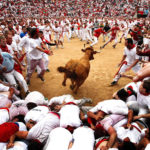
Видео
Забег быков в Испании
Захватывающее зрелище — забег быков (Энсьерро) на празднике Сан-Фермин в Испании.
Когда и где проводится бег быков в Испании?
Каждый год с 6 по 14 июля бег быков проводится в столице испанской провинции Наварра – Памплоне. В 2020-2021 году в связи с пандемией коронавируса фестиваль был отменен.
Кто может принять участие?
Все люди, достигшие 18-летия. Трезвые, в здравом уме и памяти.
Мероприятие опасно?
Да, очень. Поэтому через каждые 50 м расположены медицинские посты.
Как называют бегунов от быка?
Бегуны зовуться «Мозос»
Но больше всего они приходят на «Бег быков» энсьерро (Running of the bulls), когда бесстрашные (или глупые) авантюристы, которых называют мозо, бросаются на путь шести разъяренных быков. Первоначально праздник отмечался как праздник святого, а теперь он длится девять дней, с 6 по 14 июля.
Следующая
КультураИспанский фестиваль Ла Томатина
This article is about the primarily continental European practice. For the defunct English practice, see Bull running.
| Running of the bulls | |
|---|---|

The bull run in Pamplona |
|
| Dates | 7–14 July (in 2022) |
| Location(s) | Pamplona and other |
Runners surround the bulls on Estafeta Street
A running of the bulls (Spanish: encierro, from the verb encerrar, ‘to corral, to enclose’; Occitan: abrivado, literally ‘haste, momentum’; Catalan: correbous, ‘run-bulls’) is an event that involves running in front of a small group of bulls, typically six[1] but sometimes ten or more, that have been let loose on sectioned-off streets in a town,[1] usually as part of a summertime festival. Particular breeds of cattle may be favored, such as the toro bravo in Spain,[1] also often used in post-run bullfighting, and Camargue cattle in Occitan France, which are not fought. Bulls (non-castrated male cattle) are typically used in such events.
The most famous bull-run is the encierro held in Pamplona during the nine-day festival of Sanfermines in honor of Saint Fermin.[2] It has become a major global tourism event, today very different from the traditional, local festival. More traditional summer bull-runs are held in other places such as towns and villages across Spain and Portugal, in some cities in Mexico,[3] and in the Occitan (Camargue) region of southern France. Bull-running was formerly also practiced in rural England, most famously at Stamford until 1837.
History[edit]
The event has its origins in the old practice of transporting bulls from the fields outside the city, where they were bred, to the bullring, where they would be killed in the evening.[4] During this «run», local youths would jump among them in a display of bravado. In Pamplona and other places, the six bulls that run are also in that afternoon’s bullfight.
Spanish tradition holds that bull-running began in northeastern Spain in the early 14th century. Cattle herders who wanted to transport their animals from barges or from the countryside into city centers for sale or bullfights needed an easy way to move their precious animals. While transporting cattle in order to sell them at the market, men would try to speed the process by hurrying their cattle using tactics of fear and excitement. After years of this practice, the transportation and hurrying began to turn into a competition, as young adults would attempt to race in front of the bulls and make it safely to their pens without being overtaken. When the popularity of this practice increased and was noticed more and more by the expanding population of Spanish cities, a tradition was created and stands to this day.[5][non-primary source needed]
The Running was cancelled in 2020 and 2021 due to the COVID-19 pandemic in Spain, but resumed 7–14 July 2022.[6][7]
Pamplona bull run[edit]
Saint Fermin, honored in Pamplona
Pamplona, 7 July 2005. People climb to the fences as the bulls run by and cross the Town Hall Plaza.
The Pamplona[2] encierro is the most popular in Spain and has been broadcast live by RTVE, the public Spanish national television channel, for over 30 years.[8] It is the highest-profile event of the San Fermín festival, which is held every year from 6–14 July.[2] The first bull running is on 7 July, followed by one on each of the following mornings of the festival, beginning every day at 8 am. The rules require participants to be at least 18 years old, run in the same direction as the bulls, not incite the bulls, and not be under the influence of alcohol.[9][10]
Fence[edit]
In Pamplona, a set of wooden fences is erected to direct the bulls along the route and to block off side streets. A double wooden fence is used in those areas where there is enough space, while in other parts the buildings of the street act as barriers. The gaps in the barricades are wide enough for a human to slip through but narrow enough to block a bull. The fence is composed of approximately three thousand separate pieces of wood. Some parts of the fence remain in place for the duration of the fiesta, while others are placed and removed each morning.[11] Spectators can only stand behind the second fence, whereas the space between the two fences is reserved for security and medical personnel and also for participants who need cover during the event.[10]
Preliminaries[edit]
Police barrier at the beginning of the running stops people until the first rocket is fired.
The encierro begins with runners singing a benediction. It is sung three times, each time being sung both in Spanish and Basque. The benediction is a prayer given at a statue of Saint Fermin, patron of the festival and the city, to ask the saint’s protection and can be translated into English as «We ask Saint Fermin, as our Patron, to guide us through the encierro and give us his blessing». The singers finish by shouting «¡Viva San Fermín! and Gora San Fermin! (‘Long live Saint Fermin’, in Spanish and Basque, respectively).[9] Most runners dress in the traditional clothing of the festival which consists of a white shirt and trousers with a red waistband (faja) and neckerchief (pañuelo). Also some of them hold the day’s newspaper rolled to draw the bulls’ attention from them if necessary.[9]
The running[edit]
Runners at the Pamplona bull run in typical attire
Pamplona, 2007. Bulls following some runners enter the bull ring from the callejón, where the event ends. The bulls can be seen in the foreground and background of the picture.
A first rocket is set off at 8 a.m. to alert the runners that the corral gate is open. A second rocket signals that all six bulls have been released. The third and fourth rockets are signals that all of the herd has entered the bullring and its corral respectively, marking the end of the event.[9] The average duration between the first rocket and the end of the encierro is two minutes, 30 seconds.[9]
The encierro is usually composed of the six bulls to be fought in the afternoon, six steers that run in herd with the bulls, and three more steers that follow the herd to encourage any reluctant bulls to continue along the route. The function of the steers, who run the route daily, is to guide the bulls to the bullring.[9] The average speed of the herd is 24 km/h (15 mph).[9]
The length of the run is 875 meters (957 yards). It goes through four streets of the old part of the city (Santo Domingo, Ayuntamiento, Mercaderes and Estafeta) via the Town Hall Square and the short section «Telefónica» (named for the location of the old telephone office at end of Calle Estafeta) just before entering into the bullring through its callejón (tunnel).[2] The fastest part of the route is up Santo Domingo and across the Town Hall Square, but the bulls often became separated at the entrance to Estafeta Street as they slow down. One or more would slip going into the turn at Estafeta («la curva»), resulting in the installation of anti-slip surfacing, and now most of the bulls negotiate the turn onto Estafeta and are often ahead of the steers. This has resulted in a quicker run. Runners are not permitted in the first 50 meters of the encierro, which is an uphill grade where the bulls are much faster.[citation needed]
Injuries, fatalities, and medical attention[edit]
Two injured runners are treated by medical services.
Every year, between 50 and 100 people are injured during the run.[9] Not all of the injuries require taking the patients to hospital: in 2013, 50 people were taken by ambulance to Pamplona’s hospital, with this number nearly doubling that of 2012.[12]
Goring is much less common but potentially life threatening. In 2013, for example, six participants were gored along the festival, in 2012, only four runners were injured by the horns of the bulls with exactly the same number of gored people in 2011, nine in 2010 and 10 in 2009; with one of these last killed.[12][13] As most of the runners are male, only 5 women have been gored since 1974. Before that date, running was prohibited for women.[14]
Another major risk is runners falling and piling up (a «montón») at the entrance of the bullring, which acts as a funnel as it is much narrower than the previous street, resulting in a crowd crush. In such cases, injuries come both from asphyxia and contusions to those in the pile and from goring if the bulls crush into the pile. This kind of blocking of the entrance has occurred at least ten times in the history of the run, the last occurring in 2013 and the first dating back to 1878. A runner died of suffocation in one such pile up in 1977.[15]
Overall, since record-keeping began in 1910, 15 people have been killed in the bull running of Pamplona, most of them due to being gored.[9] To minimize the impact of injuries every day 200 people collaborate in the medical attention. They are deployed in 16 sanitary posts (every 50 metres on average), each one with at least a physician and a nurse among their personnel. Most of these 200 people are volunteers, mainly from the Red Cross. In addition to the medical posts, there are around 20 ambulances. This organization makes it possible to have a gored person stabilized and taken to a hospital in less than 10 minutes.[16]
In 2021 a man bled to death after he was repeatedly gored at a bull-running festival in the city of Onda in eastern Spain.[17]
| Year | Name | Age | Origin | Location | Cause of death |
|---|---|---|---|---|---|
| 1924 | Esteban Domeño | 22 | Navarre, Spain | Telefónica | Goring[18] |
| 1927 | Santiago Zufía | 34 | Navarre, Spain | Bullring | Goring[18] |
| 1935 | Gonzalo Bustinduy | 29 | San Luis Potosí, Mexico | Bullring | Goring[18] |
| 1947 | Casimiro Heredia | 37 | Navarre, Spain | Estafeta | Goring[18] |
| 1947 | Julián Zabalza | 23 | Navarre, Spain | Bullring | Goring[18] |
| 1961 | Vicente Urrizola | 32 | Navarre, Spain | Santo Domingo | Goring[18] |
| 1969 | Hilario Pardo | 45 | Navarre, Spain | Santo Domingo | Goring[18] |
| 1974 | Juan Ignacio Eraso | 18 | Navarre, Spain | Telefónica | Goring[18] |
| 1975 | Gregorio Gorriz | 41 | Navarre, Spain | Bullring | Goring[18] |
| 1977 | José Joaquín Esparza | 17 | Navarre, Spain | Bullring | Suffocated in a pile-up.[9] |
| 1980 | José Antonio Sánchez | 26 | Navarre, Spain | Town Hall Square | Goring[18] |
| 1980 | Vicente Risco | 29 | Badajoz, Spain | Bullring | Goring[18] |
| 1995 | Matthew Peter Tassio | 22 | Glen Ellyn, Illinois, USA | Town Hall Square | Goring[19] |
| 2003 | Fermín Etxeberria | 62 | Navarre, Spain | Mercaderes | Goring[20] |
| 2009 | Daniel Jimeno Romero | 27 | Alcalá de Henares, Spain | Telefónica | Goring[21][22] |
Dress code[edit]
Town Hall Square in the «Poor Me».
Though there is no formal dress code, the very common and traditional attire is white trousers, a white shirt with a red cummerbund around the waist, and a red neckerchief around the neck.[23] Some have large logos on their shirts; in the Internet age this is thought to be a way to highlight someone in a photo. This dress is to honor San Fermin, the center of the celebration, because of his martyr’s death; the white outfits represent the purity and holiness of a saint, and the red kerchiefs (pañuelos), represent his death by decapitation. A common alternate color to red is blue.
Media[edit]
Hemingway drank in the Café Iruña, established 1888 in Pamplona/Iruña
The encierro of Pamplona has been depicted many times in literature, television or advertising, but became known worldwide partly because of the descriptions of Ernest Hemingway in books The Sun Also Rises and Death in the Afternoon.[24]
The cinema pioneer Louis Lumière filmed the run in 1899.[25]
The event is the basis for a chapter in James Michener’s 1971 novel The Drifters.
The run is depicted in the 1991 Billy Crystal film City Slickers, where the character «Mitch» (Crystal) is gored (non-fatally) from behind by a bull during a vacation with the other main characters.
Running of the bulls in Cellar, provincial de Segovia, Spain.
The run appears in the 2011 Bollywood movie Zindagi Na Milegi Dobara, directed by Zoya Akhtar, as the final dare in the bucket list of the three bachelors who have to overcome their ultimate fear; death. At first, the trio run part of the route. They stop at the square, but then recover their nerve, and continue to the end. The completion of the run depicts their freedom as they learn that surviving a mortal danger can bring joy.
Running with Bulls, a 2012 documentary of the festival filmed by Construct Creatives and presented by Jason Farrel, depicts the pros and cons of the controversial tradition.[26]
From 2014 until 2016, the Esquire Network broadcast the running of the bulls live in the United States,[27] with both live commentary and then a recorded ’round up’ later in the day by NBCSN commentators the Men in Blazers, including interviews with noted participants such as Madrid-born runner David Ubeda,[28] former US Army soldier turned filmmaker Dennis Clancey,[29] Joseph Distler, famous New York bull runner, and former British bullfighter and author Alexander Fiske-Harrison.[30]
In 2014, a guidebook authored by Alexander Fiske-Harrison, Joe Distler, Ernest Hemingway’s grandson John, Orson Welles’ daughter Beatrice, and with a foreword by the Mayor of Pamplona, caused headlines around the world when one of the contributors, Bill Hillmann, was gored by a bull soon after its publication. It was republished in 2017 under the title The Bulls Of Pamplona with a replacement chapter by Dennis Clancey.[31]
The award-winning 2015 feature documentary Chasing Red directed by Dennis Clancey, follows four runners during the 2012 fiesta in Pamplona, including Bill Hillmann and David Ubeda.[32][33][34]
Other examples[edit]
Although the most famous running of the bulls is that of San Fermín,[2] they are held in towns and villages across Spain, Portugal, and in some cities in southern France during the summer. Examples are the bull run of San Sebastián de los Reyes, near Madrid, at the end of August which is the most popular of Spain after Pamplona, the bull run of Cuéllar, considered as the oldest of Spain since there are documents of its existence dating back to 1215, the Highland Capeias of the Raia in Sabugal, Portugal, with horses leading the herd crossing old border passes out of Spain and using the medieval ‘Forcåo’, or the bull run of Navalcarnero held at night.
Other encierros have also caused fatalities.[35]
Correbous or bous al carrer[edit]
Bous al carrer, correbou or correbous (meaning in Catalan, ‘bulls in the street’, ‘street-bulls’ or ‘bull-running’) is a typical festivity in many villages in the Valencian region, Terres de l’Ebre, Catalonia, and Fornalutx, Mallorca. Another similar tradition is soltes de vaques, where cows are used instead of bulls. Even though they can take place all along the year, they are most usual during local festivals (normally in August). Compared to encierros, animals are not directed to any bullring.
These festivities are normally organized by the youngsters of the village, as a way for showing their courage and ability with the bull. Some sources consider this tradition a masculine initiation rite to adulthood.[36]
Occitan area of France[edit]
An abrivado at Calvisson. The guardians are demonstrating their skill in turn a group of at least four bulls through a 360-degree turn
A bandido at Calvisson. Contact has been made with the bull: but it has not yet been stopped.
Numerous bull-running events happen in France in the region around Sommières, in accordance with the Camargues tradition, in which no bulls are intentionally injured or killed. For instance, in Calvisson, the annual event takes place around 20 July over a period of five days. There are four events: the abrivado, in which at least ten bulls are run together through the street guided by a group of twelve gardians mounted on white Camargue horses; the encierro, in which one bull is released outside the foyer and finds his own way back to the pen; the bandido, in which one bull is run, accompanied through the streets; and the bandido de nuit, which is the same thing but after dark. Boys and men run with the bulls and try and separate them from the horses, stop them, and physically turn them away from the horses.
[37]
Stamford bull run[edit]
The English town of Stamford, Lincolnshire was host to the Stamford bull run for almost 700 years until it was abandoned in 1837.[38] According to local tradition, the custom dated from the time of King John when William de Warenne, 5th Earl of Surrey, saw two bulls fighting in the meadow beneath. Some butchers came to part the combatants and one of the bulls ran into the town, causing a great uproar. The earl, mounting his horse, rode after the animal, and enjoyed the sport so much, that he gave the meadow in which the fight began, to the butchers of Stamford, on condition that they should provide a bull, to be run in the town every 13 November, for ever after. As of 2013 the bull run had been revived as a ceremonial, festival-style community event.
Mock bull runs[edit]
A variation is the nightly «fire bull» where balls of inflammable material are placed on the horns. Currently the bull is often replaced by a runner carrying a frame on which fireworks are placed and dodgers, usually children, run to avoid the sparks.
The Encierro de la Villavesa («running of the town bus») started in Pamplona on 15 July 1984 when, after the end of the festival, youths would run before the earliest urban bus entering the traditional encierro course.
Starting in 1990, the Pamplona bus company detoured the early bus to defuse the risk.
Currently, the youths run before a cyclist in a yellow jersey as an homage to the Navarrese cycling champion Miguel Induráin.[39]
In 2008, Red Bull Racing driver David Coulthard and Scuderia Toro Rosso driver Sébastien Bourdais performed a version of a ‘bull running’ event in Pamplona, Spain, with the Formula One cars chasing 500 runners through the actual Pamplona route.[40]
The Big Easy Rollergirls roller derby team has performed an annual mock bull run in New Orleans, Louisiana since 2007. The team, dressed as bulls, skates after runners through the French Quarter. In 2012, there were 14,000 runners and over 400 «bulls» from all over the country, with huge before- and after-parties.[41][42][43]
In Ballyjamesduff, Ireland, an annual event called the Pig Run is held with small pigs. It looks just like a mini-encierro but with pigs instead of bulls.
In Dewey Beach, Delaware, a bar named The Starboard sponsors an annual Running of the Bull [sic], in which hundreds of red- and white-clad beachgoers are chased down the shore by a single «bull» (two people in a pantomime horse-style costume).[44]
In Rangiora, New Zealand, an annual Running of the Sheep is held, in which 1000–2000 sheep are released down the main street of the small farming town.
The Running of the Bulls UK is a pub crawl event that takes place on London’s Hampstead Heath and uses fast human runners in place of bulls.
In 2014, Pamplona inaugurated a series of running events in June, the San Fermín Marathon, of a full marathon (42.195 km), half-marathon (21.097 km), or 10 km road race that concludes with the final 900m of each race using the encierro route, runners crossing the finish line inside the bullring.[45]
Since 2008 in Anchorage, Alaska during the Fur Rendezvous Festival the Running of the Reindeer sends «herds» of people running down a four-block downtown street, with a group of reindeer released behind them.
Opposition[edit]
Many opponents state that bulls are mentally stressed by the harassment and voicing of both participants and spectators, and some of animals may also die because of the stress, especially if they are roped or bring flares in their horns (bou embolat version).[46] Despite all this, the festivities seem to have wide popular support in their villages.[47]
The city of San Miguel de Allende, Mexico, cancelled its Sanmiguelada running of the bulls after 2006, citing public disorder associated with the event.[48] After the event was cancelled in San Miguel, the city of Salvatierra, also in the state of Guanajuato, picked up the event. It is now called La Marquesada and the three-day event is held during the last weekend of the month of September or first weekend of October.
As of 2002, a Running of the Nudes occurs two days before the running of the bulls. The event is supported by animal welfare groups, including PETA, who object to the running of the bulls, claiming that it is cruel and glorifies bullfighting, which the groups oppose.
Further reading[edit]
- Fiske-Harrison, Alexander, ed. (2018). The Bulls Of Pamplona (1 ed.). Mephisto Press. ISBN 978-1986500272.
- Hillmann, Bill (2015). Mozos: A Decade Running with the Bulls of Spain. Chicago, Illinois: Curbside Splendor Publishing. ISBN 978-1-9404-3053-9.
- Hillmann, Bill (2021). The Pueblos: My Quest to Run 101 Bull Runs in the Small Towns of Spain. Chicago, Illinois: Tortoise Books. ISBN 978-1-9489-5417-4.
- Etxanobe, Ander (2021). The Basque: An American’s Journey to Embrace His Roots. Txapela Publishing. ISBN 978-1736948101.
See also[edit]
- Bou embolat or toro embolado – variant in which bulls have flares or fireworks attached to their horns
- Bull-baiting
- Bullfighting
- Spanish-style bullfighting
- Bull-leaping (ancient)
- Course landaise (modern France)
- Recortes (modern Spain)
- Bull running – a similar, defunct tradition in England
- Jallikattu – a similar tradition in Tamil Nadu, India
- Sokamuturra, similar to the encierro, spread over different parts of the Basque Country
References[edit]
Some links may contain graphic content where marked.
- ^ a b c Fiske-Harrison, Alexander (editor) The Bulls Of Pamplona, Mephisto Press, 2018
- ^ a b c d e «Sanfermin guide: Running of the bulls». Kukuxumusu. 2007. Archived from the original on 5 May 2008. Retrieved 21 July 2008.
- ^ «Bull-run hits liquor-fueled town», 2 February 2009. «The tradition, enacted in a handful of Mexican towns, traces its roots back to the centuries-old Pamplona bull-run in Mexico’s former colonial power.» Retrieved 4 March 2009.
- ^ According to the Mayor of Pamplona in his foreword to the book Fiesta: How to Survive the Bulls of Pamplona
- ^ «Running of the Bulls 2011 Live Stream, Pamplona San Fermin Festival Webcam Feed». PRLog. 5 July 2011.
- ^ «Running of the Bulls 2021 Officially Cancelled». www.runningofthebulls.com. 26 April 2021. Retrieved 6 July 2021.
- ^ «Running of the Bulls 2022 Dates». www.runningofthebulls.com. 5 April 2021. Retrieved 6 July 2021.
- ^ «27 años de Sanfermines en TVE». RTVE.es. Corporación de Radio y Televisión Española. 2008. Retrieved 21 July 2008.
- ^ a b c d e f g h i j k «The Bull Run». Pamplona.net. Ayuntamiento de Pamplona (Council of Pamplona). 2008. Archived from the original on 29 May 2008. Retrieved 21 July 2008.
- ^ a b «Sección quinta». Bando San Fermin 2014. Ayuntamiento de Pamplona. Archived from the original on 2 April 2015. Retrieved 20 March 2015.
- ^ «Encierro bullrun San Fermin festival Sanfermines tourist information on Navarre». Government of Navarre. Retrieved 8 March 2010.
- ^ a b Alonso, Gorka (15 July 2013). «Los encierros se saldan con 50 heridos trasladados y 6 corneados». Noticias de Navarra (in Spanish). Archived from the original on 16 July 2013. Retrieved 15 July 2013.
- ^ «Los encierros de 2012 dejan cuatro heridos por asta, los mismos que en 2011». Diario de Noticias (in Spanish). 14 July 2012. Archived from the original on 19 July 2012. Retrieved 13 July 2013.
- ^ «Quinta mujer corneada en los encierros de San Fermín» (in Spanish). Diario de Navarra. EFE. 14 July 2013. Retrieved 15 July 2013.
- ^ Doria, Javier (13 July 2013). «Montón en el encierro de Sanfermines, un peligro con historia». El País (in Spanish). Retrieved 14 July 2013.
- ^ «Especialistas destacan que el dispositivo sanitario de los encierros «no se puede mejorar» porque es «espectacular»«. Diario de Navarra (in Spanish). 18 June 2009. Archived from the original on 4 November 2013. Retrieved 16 July 2013.
- ^ «Man dies after being gored at Spanish bull-running festival». Reuters. 31 October 2021.
- ^ a b c d e f g h i j k «La muerte de hoy es la número quince en la historia del encierro». Terra Noticias (in Spanish). Retrieved 6 July 2012.
- ^ «The last person killed at Pamplona». BBC News. British Broadcasting Corporation. 14 July 2005. Retrieved 10 July 2009.
…Matthew Tassio…22 years old and came from Chicago…The…bull…hit him in the abdomen, severed a main artery, sliced through his kidney and punctured his liver
- ^ «Muere el pamplonés Fermín Etxeberria, de 63 años, herido en el encierro del 8 de julio». DiarioDeNavarra.es (in Spanish). 25 September 2003. Archived from the original on 3 August 2009. Retrieved 10 July 2009.
- ^ «Bull gores man to death in Spain». BBC News. 10 July 2009. Retrieved 10 July 2009.
The 27-year-old was gored in the neck on Friday, during the fourth bull run of the week-long San Fermin festival. Daniel Jimeno Romero, from Madrid, had emergency surgery in hospital but died of his injuries. Earlier reports had described the dead man as British….a veteran Spanish bull-runner died after a fall in 2003
- ^ «One dead in the running of the bull’s in Pamplona». EncierroSanFermin.com. 10 July 2009. Archived from the original on 14 July 2009. Retrieved 10 July 2009.
A runner died in today’s running of the bulls in the northern spanish city of Pamplona, the bull running held during the famous San Fermin festivities. The man died after being gored in the neck and lung by a bull of the Jandilla ranch, named «Capuchino».The runner, Daniel Jimeno Romero from Alcalá de Henares (Madrid) was at the end of the street run
- ^ Tan, Rebecca (6 July 2018). «As bull run revelry kicks off in Pamplona, hundreds wear black to mourn victims of sexual assault». Washington Post.
- ^ «Hemingway in Spain. A definitive guide to Ernest Hemingway’s Spain». 15 March 2022.
- ^ Encierro de toros in the Spanish-language Auñamendi Encyclopedia.
- ^ Running with Bulls at IMDb
- ^ ‘Running Of The Bulls’, Esquire TV
- ^ Vadillo, Jose Luis. ‘Así son los corredores de elite en San Fermín’, El Mundo. 6 July 2015
- ^ Editorial Staff. «Pamplona, bull running, bull gorings, Esquire TV and poetry from New York», The Pamplona Post. 10 July 2015
- ^ «Running of the Bulls 2015: A Democratic Sport» Archived 17 July 2015 at the Wayback Machine, Esquire TV
- ^ Fiske-Harrison, Alexander, «The Bulls Of Pamplona
- ^ «The People Trying to Use Technology to Save Nature». 15 May 2021.
- ^ «Chasing Red (2020) — IMDb». IMDb.
- ^ «This Iraq war veteran has been running with the bulls since 2007». 5 February 2020.
- ^ Mari Carmen López del Burgo, aged 48, from Madrid, Spain. «Muere una mujer embestida por un toro en los encierros de Arganda del Rey». ElPais.com (in Spanish). 9 September 2010. Retrieved 9 September 2010.
- ^ Touristic leaflet. Festes de la Costa Blanca, Diputació Provincial d’Alacant, 2006, Alacant.
- ^ «Taurine traditions». OT-Sommieres.com. Office de Tourisme du Pays de Sommières. Retrieved 22 August 2017.
- ^ Chambers Book of Days (1864). W. & R. Chambers Ltd. 1832. 13 November entry
- ^ Rolán, Saioa (8 June 2022). «Encierro de la Villavesa: qué es, cuándo se celebra y curiosidades». diariodenavarra.es (in European Spanish). Retrieved 7 July 2022.
- ^ «Red Bull to visit Pamplona for Bull running». GPUpdate.net. 11 June 2008. Retrieved 30 January 2011.
- ^ Marszalek, Keith I. (24 June 2007). «Big Easy Rollergirls to reinact [sic] famed bull run». Blog.NOLA.com. Retrieved 2 July 2011.
- ^ «San Fermín in Nueva Orleans, The Running of the Roller Girls». Laughing Squid. 20 July 2008. Retrieved 2 July 2011.
- ^ Coviello, Will. «Running of the Bulls 2012». Gambit Weekly. Retrieved 18 July 2012.
- ^
- Cormier, Ryan (23 June 2017). «Turning 21, party time for Running of the Bull». The News Journal. Wilmington, DE.
- Driscoll, Ellen (5 July 2019). «Running of the Bull takes over Dewey Beach». Cape Gazette. Lewes, DE.
- Gonzalez, Lucas (26 June 2019). «Dewey Beach’s Running of the Bull: The zany hit of summer». The Daily Times. Salisbury, MD.
- ^ «Home2018 — EDP San Fermín Marathon». SanFerminMarathon.com.
- ^ Article sobre la crueltat dels bous al carrer. Archived 12 October 2007 at the Wayback Machine (in Catalan)
- ^ Article sobre la popularitat dels bous al carrer a les terres de l’Ebre. (in Catalan)
- ^ «No More Bull (Running, That Is) in San Miguel de Allende,» Archived 7 June 2011 at the Wayback Machine Austin American-Statesman, 24 May 2007. Retrieved 4 March 2009
External links[edit]
- Definitive Guide to Running with Bulls, Pamplona’s Running of the Bulls, How To
- A blog about Pamplona’s annual bull-running festival
- How to attend or view the Pamplona festival
- Student Travel and Party at Running of the Bulls
- Google Maps Route Map
- Running of the Bulls Tours
This article is about the primarily continental European practice. For the defunct English practice, see Bull running.
| Running of the bulls | |
|---|---|

The bull run in Pamplona |
|
| Dates | 7–14 July (in 2022) |
| Location(s) | Pamplona and other |
Runners surround the bulls on Estafeta Street
A running of the bulls (Spanish: encierro, from the verb encerrar, ‘to corral, to enclose’; Occitan: abrivado, literally ‘haste, momentum’; Catalan: correbous, ‘run-bulls’) is an event that involves running in front of a small group of bulls, typically six[1] but sometimes ten or more, that have been let loose on sectioned-off streets in a town,[1] usually as part of a summertime festival. Particular breeds of cattle may be favored, such as the toro bravo in Spain,[1] also often used in post-run bullfighting, and Camargue cattle in Occitan France, which are not fought. Bulls (non-castrated male cattle) are typically used in such events.
The most famous bull-run is the encierro held in Pamplona during the nine-day festival of Sanfermines in honor of Saint Fermin.[2] It has become a major global tourism event, today very different from the traditional, local festival. More traditional summer bull-runs are held in other places such as towns and villages across Spain and Portugal, in some cities in Mexico,[3] and in the Occitan (Camargue) region of southern France. Bull-running was formerly also practiced in rural England, most famously at Stamford until 1837.
History[edit]
The event has its origins in the old practice of transporting bulls from the fields outside the city, where they were bred, to the bullring, where they would be killed in the evening.[4] During this «run», local youths would jump among them in a display of bravado. In Pamplona and other places, the six bulls that run are also in that afternoon’s bullfight.
Spanish tradition holds that bull-running began in northeastern Spain in the early 14th century. Cattle herders who wanted to transport their animals from barges or from the countryside into city centers for sale or bullfights needed an easy way to move their precious animals. While transporting cattle in order to sell them at the market, men would try to speed the process by hurrying their cattle using tactics of fear and excitement. After years of this practice, the transportation and hurrying began to turn into a competition, as young adults would attempt to race in front of the bulls and make it safely to their pens without being overtaken. When the popularity of this practice increased and was noticed more and more by the expanding population of Spanish cities, a tradition was created and stands to this day.[5][non-primary source needed]
The Running was cancelled in 2020 and 2021 due to the COVID-19 pandemic in Spain, but resumed 7–14 July 2022.[6][7]
Pamplona bull run[edit]
Saint Fermin, honored in Pamplona
Pamplona, 7 July 2005. People climb to the fences as the bulls run by and cross the Town Hall Plaza.
The Pamplona[2] encierro is the most popular in Spain and has been broadcast live by RTVE, the public Spanish national television channel, for over 30 years.[8] It is the highest-profile event of the San Fermín festival, which is held every year from 6–14 July.[2] The first bull running is on 7 July, followed by one on each of the following mornings of the festival, beginning every day at 8 am. The rules require participants to be at least 18 years old, run in the same direction as the bulls, not incite the bulls, and not be under the influence of alcohol.[9][10]
Fence[edit]
In Pamplona, a set of wooden fences is erected to direct the bulls along the route and to block off side streets. A double wooden fence is used in those areas where there is enough space, while in other parts the buildings of the street act as barriers. The gaps in the barricades are wide enough for a human to slip through but narrow enough to block a bull. The fence is composed of approximately three thousand separate pieces of wood. Some parts of the fence remain in place for the duration of the fiesta, while others are placed and removed each morning.[11] Spectators can only stand behind the second fence, whereas the space between the two fences is reserved for security and medical personnel and also for participants who need cover during the event.[10]
Preliminaries[edit]
Police barrier at the beginning of the running stops people until the first rocket is fired.
The encierro begins with runners singing a benediction. It is sung three times, each time being sung both in Spanish and Basque. The benediction is a prayer given at a statue of Saint Fermin, patron of the festival and the city, to ask the saint’s protection and can be translated into English as «We ask Saint Fermin, as our Patron, to guide us through the encierro and give us his blessing». The singers finish by shouting «¡Viva San Fermín! and Gora San Fermin! (‘Long live Saint Fermin’, in Spanish and Basque, respectively).[9] Most runners dress in the traditional clothing of the festival which consists of a white shirt and trousers with a red waistband (faja) and neckerchief (pañuelo). Also some of them hold the day’s newspaper rolled to draw the bulls’ attention from them if necessary.[9]
The running[edit]
Runners at the Pamplona bull run in typical attire
Pamplona, 2007. Bulls following some runners enter the bull ring from the callejón, where the event ends. The bulls can be seen in the foreground and background of the picture.
A first rocket is set off at 8 a.m. to alert the runners that the corral gate is open. A second rocket signals that all six bulls have been released. The third and fourth rockets are signals that all of the herd has entered the bullring and its corral respectively, marking the end of the event.[9] The average duration between the first rocket and the end of the encierro is two minutes, 30 seconds.[9]
The encierro is usually composed of the six bulls to be fought in the afternoon, six steers that run in herd with the bulls, and three more steers that follow the herd to encourage any reluctant bulls to continue along the route. The function of the steers, who run the route daily, is to guide the bulls to the bullring.[9] The average speed of the herd is 24 km/h (15 mph).[9]
The length of the run is 875 meters (957 yards). It goes through four streets of the old part of the city (Santo Domingo, Ayuntamiento, Mercaderes and Estafeta) via the Town Hall Square and the short section «Telefónica» (named for the location of the old telephone office at end of Calle Estafeta) just before entering into the bullring through its callejón (tunnel).[2] The fastest part of the route is up Santo Domingo and across the Town Hall Square, but the bulls often became separated at the entrance to Estafeta Street as they slow down. One or more would slip going into the turn at Estafeta («la curva»), resulting in the installation of anti-slip surfacing, and now most of the bulls negotiate the turn onto Estafeta and are often ahead of the steers. This has resulted in a quicker run. Runners are not permitted in the first 50 meters of the encierro, which is an uphill grade where the bulls are much faster.[citation needed]
Injuries, fatalities, and medical attention[edit]
Two injured runners are treated by medical services.
Every year, between 50 and 100 people are injured during the run.[9] Not all of the injuries require taking the patients to hospital: in 2013, 50 people were taken by ambulance to Pamplona’s hospital, with this number nearly doubling that of 2012.[12]
Goring is much less common but potentially life threatening. In 2013, for example, six participants were gored along the festival, in 2012, only four runners were injured by the horns of the bulls with exactly the same number of gored people in 2011, nine in 2010 and 10 in 2009; with one of these last killed.[12][13] As most of the runners are male, only 5 women have been gored since 1974. Before that date, running was prohibited for women.[14]
Another major risk is runners falling and piling up (a «montón») at the entrance of the bullring, which acts as a funnel as it is much narrower than the previous street, resulting in a crowd crush. In such cases, injuries come both from asphyxia and contusions to those in the pile and from goring if the bulls crush into the pile. This kind of blocking of the entrance has occurred at least ten times in the history of the run, the last occurring in 2013 and the first dating back to 1878. A runner died of suffocation in one such pile up in 1977.[15]
Overall, since record-keeping began in 1910, 15 people have been killed in the bull running of Pamplona, most of them due to being gored.[9] To minimize the impact of injuries every day 200 people collaborate in the medical attention. They are deployed in 16 sanitary posts (every 50 metres on average), each one with at least a physician and a nurse among their personnel. Most of these 200 people are volunteers, mainly from the Red Cross. In addition to the medical posts, there are around 20 ambulances. This organization makes it possible to have a gored person stabilized and taken to a hospital in less than 10 minutes.[16]
In 2021 a man bled to death after he was repeatedly gored at a bull-running festival in the city of Onda in eastern Spain.[17]
| Year | Name | Age | Origin | Location | Cause of death |
|---|---|---|---|---|---|
| 1924 | Esteban Domeño | 22 | Navarre, Spain | Telefónica | Goring[18] |
| 1927 | Santiago Zufía | 34 | Navarre, Spain | Bullring | Goring[18] |
| 1935 | Gonzalo Bustinduy | 29 | San Luis Potosí, Mexico | Bullring | Goring[18] |
| 1947 | Casimiro Heredia | 37 | Navarre, Spain | Estafeta | Goring[18] |
| 1947 | Julián Zabalza | 23 | Navarre, Spain | Bullring | Goring[18] |
| 1961 | Vicente Urrizola | 32 | Navarre, Spain | Santo Domingo | Goring[18] |
| 1969 | Hilario Pardo | 45 | Navarre, Spain | Santo Domingo | Goring[18] |
| 1974 | Juan Ignacio Eraso | 18 | Navarre, Spain | Telefónica | Goring[18] |
| 1975 | Gregorio Gorriz | 41 | Navarre, Spain | Bullring | Goring[18] |
| 1977 | José Joaquín Esparza | 17 | Navarre, Spain | Bullring | Suffocated in a pile-up.[9] |
| 1980 | José Antonio Sánchez | 26 | Navarre, Spain | Town Hall Square | Goring[18] |
| 1980 | Vicente Risco | 29 | Badajoz, Spain | Bullring | Goring[18] |
| 1995 | Matthew Peter Tassio | 22 | Glen Ellyn, Illinois, USA | Town Hall Square | Goring[19] |
| 2003 | Fermín Etxeberria | 62 | Navarre, Spain | Mercaderes | Goring[20] |
| 2009 | Daniel Jimeno Romero | 27 | Alcalá de Henares, Spain | Telefónica | Goring[21][22] |
Dress code[edit]
Town Hall Square in the «Poor Me».
Though there is no formal dress code, the very common and traditional attire is white trousers, a white shirt with a red cummerbund around the waist, and a red neckerchief around the neck.[23] Some have large logos on their shirts; in the Internet age this is thought to be a way to highlight someone in a photo. This dress is to honor San Fermin, the center of the celebration, because of his martyr’s death; the white outfits represent the purity and holiness of a saint, and the red kerchiefs (pañuelos), represent his death by decapitation. A common alternate color to red is blue.
Media[edit]
Hemingway drank in the Café Iruña, established 1888 in Pamplona/Iruña
The encierro of Pamplona has been depicted many times in literature, television or advertising, but became known worldwide partly because of the descriptions of Ernest Hemingway in books The Sun Also Rises and Death in the Afternoon.[24]
The cinema pioneer Louis Lumière filmed the run in 1899.[25]
The event is the basis for a chapter in James Michener’s 1971 novel The Drifters.
The run is depicted in the 1991 Billy Crystal film City Slickers, where the character «Mitch» (Crystal) is gored (non-fatally) from behind by a bull during a vacation with the other main characters.
Running of the bulls in Cellar, provincial de Segovia, Spain.
The run appears in the 2011 Bollywood movie Zindagi Na Milegi Dobara, directed by Zoya Akhtar, as the final dare in the bucket list of the three bachelors who have to overcome their ultimate fear; death. At first, the trio run part of the route. They stop at the square, but then recover their nerve, and continue to the end. The completion of the run depicts their freedom as they learn that surviving a mortal danger can bring joy.
Running with Bulls, a 2012 documentary of the festival filmed by Construct Creatives and presented by Jason Farrel, depicts the pros and cons of the controversial tradition.[26]
From 2014 until 2016, the Esquire Network broadcast the running of the bulls live in the United States,[27] with both live commentary and then a recorded ’round up’ later in the day by NBCSN commentators the Men in Blazers, including interviews with noted participants such as Madrid-born runner David Ubeda,[28] former US Army soldier turned filmmaker Dennis Clancey,[29] Joseph Distler, famous New York bull runner, and former British bullfighter and author Alexander Fiske-Harrison.[30]
In 2014, a guidebook authored by Alexander Fiske-Harrison, Joe Distler, Ernest Hemingway’s grandson John, Orson Welles’ daughter Beatrice, and with a foreword by the Mayor of Pamplona, caused headlines around the world when one of the contributors, Bill Hillmann, was gored by a bull soon after its publication. It was republished in 2017 under the title The Bulls Of Pamplona with a replacement chapter by Dennis Clancey.[31]
The award-winning 2015 feature documentary Chasing Red directed by Dennis Clancey, follows four runners during the 2012 fiesta in Pamplona, including Bill Hillmann and David Ubeda.[32][33][34]
Other examples[edit]
Although the most famous running of the bulls is that of San Fermín,[2] they are held in towns and villages across Spain, Portugal, and in some cities in southern France during the summer. Examples are the bull run of San Sebastián de los Reyes, near Madrid, at the end of August which is the most popular of Spain after Pamplona, the bull run of Cuéllar, considered as the oldest of Spain since there are documents of its existence dating back to 1215, the Highland Capeias of the Raia in Sabugal, Portugal, with horses leading the herd crossing old border passes out of Spain and using the medieval ‘Forcåo’, or the bull run of Navalcarnero held at night.
Other encierros have also caused fatalities.[35]
Correbous or bous al carrer[edit]
Bous al carrer, correbou or correbous (meaning in Catalan, ‘bulls in the street’, ‘street-bulls’ or ‘bull-running’) is a typical festivity in many villages in the Valencian region, Terres de l’Ebre, Catalonia, and Fornalutx, Mallorca. Another similar tradition is soltes de vaques, where cows are used instead of bulls. Even though they can take place all along the year, they are most usual during local festivals (normally in August). Compared to encierros, animals are not directed to any bullring.
These festivities are normally organized by the youngsters of the village, as a way for showing their courage and ability with the bull. Some sources consider this tradition a masculine initiation rite to adulthood.[36]
Occitan area of France[edit]
An abrivado at Calvisson. The guardians are demonstrating their skill in turn a group of at least four bulls through a 360-degree turn
A bandido at Calvisson. Contact has been made with the bull: but it has not yet been stopped.
Numerous bull-running events happen in France in the region around Sommières, in accordance with the Camargues tradition, in which no bulls are intentionally injured or killed. For instance, in Calvisson, the annual event takes place around 20 July over a period of five days. There are four events: the abrivado, in which at least ten bulls are run together through the street guided by a group of twelve gardians mounted on white Camargue horses; the encierro, in which one bull is released outside the foyer and finds his own way back to the pen; the bandido, in which one bull is run, accompanied through the streets; and the bandido de nuit, which is the same thing but after dark. Boys and men run with the bulls and try and separate them from the horses, stop them, and physically turn them away from the horses.
[37]
Stamford bull run[edit]
The English town of Stamford, Lincolnshire was host to the Stamford bull run for almost 700 years until it was abandoned in 1837.[38] According to local tradition, the custom dated from the time of King John when William de Warenne, 5th Earl of Surrey, saw two bulls fighting in the meadow beneath. Some butchers came to part the combatants and one of the bulls ran into the town, causing a great uproar. The earl, mounting his horse, rode after the animal, and enjoyed the sport so much, that he gave the meadow in which the fight began, to the butchers of Stamford, on condition that they should provide a bull, to be run in the town every 13 November, for ever after. As of 2013 the bull run had been revived as a ceremonial, festival-style community event.
Mock bull runs[edit]
A variation is the nightly «fire bull» where balls of inflammable material are placed on the horns. Currently the bull is often replaced by a runner carrying a frame on which fireworks are placed and dodgers, usually children, run to avoid the sparks.
The Encierro de la Villavesa («running of the town bus») started in Pamplona on 15 July 1984 when, after the end of the festival, youths would run before the earliest urban bus entering the traditional encierro course.
Starting in 1990, the Pamplona bus company detoured the early bus to defuse the risk.
Currently, the youths run before a cyclist in a yellow jersey as an homage to the Navarrese cycling champion Miguel Induráin.[39]
In 2008, Red Bull Racing driver David Coulthard and Scuderia Toro Rosso driver Sébastien Bourdais performed a version of a ‘bull running’ event in Pamplona, Spain, with the Formula One cars chasing 500 runners through the actual Pamplona route.[40]
The Big Easy Rollergirls roller derby team has performed an annual mock bull run in New Orleans, Louisiana since 2007. The team, dressed as bulls, skates after runners through the French Quarter. In 2012, there were 14,000 runners and over 400 «bulls» from all over the country, with huge before- and after-parties.[41][42][43]
In Ballyjamesduff, Ireland, an annual event called the Pig Run is held with small pigs. It looks just like a mini-encierro but with pigs instead of bulls.
In Dewey Beach, Delaware, a bar named The Starboard sponsors an annual Running of the Bull [sic], in which hundreds of red- and white-clad beachgoers are chased down the shore by a single «bull» (two people in a pantomime horse-style costume).[44]
In Rangiora, New Zealand, an annual Running of the Sheep is held, in which 1000–2000 sheep are released down the main street of the small farming town.
The Running of the Bulls UK is a pub crawl event that takes place on London’s Hampstead Heath and uses fast human runners in place of bulls.
In 2014, Pamplona inaugurated a series of running events in June, the San Fermín Marathon, of a full marathon (42.195 km), half-marathon (21.097 km), or 10 km road race that concludes with the final 900m of each race using the encierro route, runners crossing the finish line inside the bullring.[45]
Since 2008 in Anchorage, Alaska during the Fur Rendezvous Festival the Running of the Reindeer sends «herds» of people running down a four-block downtown street, with a group of reindeer released behind them.
Opposition[edit]
Many opponents state that bulls are mentally stressed by the harassment and voicing of both participants and spectators, and some of animals may also die because of the stress, especially if they are roped or bring flares in their horns (bou embolat version).[46] Despite all this, the festivities seem to have wide popular support in their villages.[47]
The city of San Miguel de Allende, Mexico, cancelled its Sanmiguelada running of the bulls after 2006, citing public disorder associated with the event.[48] After the event was cancelled in San Miguel, the city of Salvatierra, also in the state of Guanajuato, picked up the event. It is now called La Marquesada and the three-day event is held during the last weekend of the month of September or first weekend of October.
As of 2002, a Running of the Nudes occurs two days before the running of the bulls. The event is supported by animal welfare groups, including PETA, who object to the running of the bulls, claiming that it is cruel and glorifies bullfighting, which the groups oppose.
Further reading[edit]
- Fiske-Harrison, Alexander, ed. (2018). The Bulls Of Pamplona (1 ed.). Mephisto Press. ISBN 978-1986500272.
- Hillmann, Bill (2015). Mozos: A Decade Running with the Bulls of Spain. Chicago, Illinois: Curbside Splendor Publishing. ISBN 978-1-9404-3053-9.
- Hillmann, Bill (2021). The Pueblos: My Quest to Run 101 Bull Runs in the Small Towns of Spain. Chicago, Illinois: Tortoise Books. ISBN 978-1-9489-5417-4.
- Etxanobe, Ander (2021). The Basque: An American’s Journey to Embrace His Roots. Txapela Publishing. ISBN 978-1736948101.
See also[edit]
- Bou embolat or toro embolado – variant in which bulls have flares or fireworks attached to their horns
- Bull-baiting
- Bullfighting
- Spanish-style bullfighting
- Bull-leaping (ancient)
- Course landaise (modern France)
- Recortes (modern Spain)
- Bull running – a similar, defunct tradition in England
- Jallikattu – a similar tradition in Tamil Nadu, India
- Sokamuturra, similar to the encierro, spread over different parts of the Basque Country
References[edit]
Some links may contain graphic content where marked.
- ^ a b c Fiske-Harrison, Alexander (editor) The Bulls Of Pamplona, Mephisto Press, 2018
- ^ a b c d e «Sanfermin guide: Running of the bulls». Kukuxumusu. 2007. Archived from the original on 5 May 2008. Retrieved 21 July 2008.
- ^ «Bull-run hits liquor-fueled town», 2 February 2009. «The tradition, enacted in a handful of Mexican towns, traces its roots back to the centuries-old Pamplona bull-run in Mexico’s former colonial power.» Retrieved 4 March 2009.
- ^ According to the Mayor of Pamplona in his foreword to the book Fiesta: How to Survive the Bulls of Pamplona
- ^ «Running of the Bulls 2011 Live Stream, Pamplona San Fermin Festival Webcam Feed». PRLog. 5 July 2011.
- ^ «Running of the Bulls 2021 Officially Cancelled». www.runningofthebulls.com. 26 April 2021. Retrieved 6 July 2021.
- ^ «Running of the Bulls 2022 Dates». www.runningofthebulls.com. 5 April 2021. Retrieved 6 July 2021.
- ^ «27 años de Sanfermines en TVE». RTVE.es. Corporación de Radio y Televisión Española. 2008. Retrieved 21 July 2008.
- ^ a b c d e f g h i j k «The Bull Run». Pamplona.net. Ayuntamiento de Pamplona (Council of Pamplona). 2008. Archived from the original on 29 May 2008. Retrieved 21 July 2008.
- ^ a b «Sección quinta». Bando San Fermin 2014. Ayuntamiento de Pamplona. Archived from the original on 2 April 2015. Retrieved 20 March 2015.
- ^ «Encierro bullrun San Fermin festival Sanfermines tourist information on Navarre». Government of Navarre. Retrieved 8 March 2010.
- ^ a b Alonso, Gorka (15 July 2013). «Los encierros se saldan con 50 heridos trasladados y 6 corneados». Noticias de Navarra (in Spanish). Archived from the original on 16 July 2013. Retrieved 15 July 2013.
- ^ «Los encierros de 2012 dejan cuatro heridos por asta, los mismos que en 2011». Diario de Noticias (in Spanish). 14 July 2012. Archived from the original on 19 July 2012. Retrieved 13 July 2013.
- ^ «Quinta mujer corneada en los encierros de San Fermín» (in Spanish). Diario de Navarra. EFE. 14 July 2013. Retrieved 15 July 2013.
- ^ Doria, Javier (13 July 2013). «Montón en el encierro de Sanfermines, un peligro con historia». El País (in Spanish). Retrieved 14 July 2013.
- ^ «Especialistas destacan que el dispositivo sanitario de los encierros «no se puede mejorar» porque es «espectacular»«. Diario de Navarra (in Spanish). 18 June 2009. Archived from the original on 4 November 2013. Retrieved 16 July 2013.
- ^ «Man dies after being gored at Spanish bull-running festival». Reuters. 31 October 2021.
- ^ a b c d e f g h i j k «La muerte de hoy es la número quince en la historia del encierro». Terra Noticias (in Spanish). Retrieved 6 July 2012.
- ^ «The last person killed at Pamplona». BBC News. British Broadcasting Corporation. 14 July 2005. Retrieved 10 July 2009.
…Matthew Tassio…22 years old and came from Chicago…The…bull…hit him in the abdomen, severed a main artery, sliced through his kidney and punctured his liver
- ^ «Muere el pamplonés Fermín Etxeberria, de 63 años, herido en el encierro del 8 de julio». DiarioDeNavarra.es (in Spanish). 25 September 2003. Archived from the original on 3 August 2009. Retrieved 10 July 2009.
- ^ «Bull gores man to death in Spain». BBC News. 10 July 2009. Retrieved 10 July 2009.
The 27-year-old was gored in the neck on Friday, during the fourth bull run of the week-long San Fermin festival. Daniel Jimeno Romero, from Madrid, had emergency surgery in hospital but died of his injuries. Earlier reports had described the dead man as British….a veteran Spanish bull-runner died after a fall in 2003
- ^ «One dead in the running of the bull’s in Pamplona». EncierroSanFermin.com. 10 July 2009. Archived from the original on 14 July 2009. Retrieved 10 July 2009.
A runner died in today’s running of the bulls in the northern spanish city of Pamplona, the bull running held during the famous San Fermin festivities. The man died after being gored in the neck and lung by a bull of the Jandilla ranch, named «Capuchino».The runner, Daniel Jimeno Romero from Alcalá de Henares (Madrid) was at the end of the street run
- ^ Tan, Rebecca (6 July 2018). «As bull run revelry kicks off in Pamplona, hundreds wear black to mourn victims of sexual assault». Washington Post.
- ^ «Hemingway in Spain. A definitive guide to Ernest Hemingway’s Spain». 15 March 2022.
- ^ Encierro de toros in the Spanish-language Auñamendi Encyclopedia.
- ^ Running with Bulls at IMDb
- ^ ‘Running Of The Bulls’, Esquire TV
- ^ Vadillo, Jose Luis. ‘Así son los corredores de elite en San Fermín’, El Mundo. 6 July 2015
- ^ Editorial Staff. «Pamplona, bull running, bull gorings, Esquire TV and poetry from New York», The Pamplona Post. 10 July 2015
- ^ «Running of the Bulls 2015: A Democratic Sport» Archived 17 July 2015 at the Wayback Machine, Esquire TV
- ^ Fiske-Harrison, Alexander, «The Bulls Of Pamplona
- ^ «The People Trying to Use Technology to Save Nature». 15 May 2021.
- ^ «Chasing Red (2020) — IMDb». IMDb.
- ^ «This Iraq war veteran has been running with the bulls since 2007». 5 February 2020.
- ^ Mari Carmen López del Burgo, aged 48, from Madrid, Spain. «Muere una mujer embestida por un toro en los encierros de Arganda del Rey». ElPais.com (in Spanish). 9 September 2010. Retrieved 9 September 2010.
- ^ Touristic leaflet. Festes de la Costa Blanca, Diputació Provincial d’Alacant, 2006, Alacant.
- ^ «Taurine traditions». OT-Sommieres.com. Office de Tourisme du Pays de Sommières. Retrieved 22 August 2017.
- ^ Chambers Book of Days (1864). W. & R. Chambers Ltd. 1832. 13 November entry
- ^ Rolán, Saioa (8 June 2022). «Encierro de la Villavesa: qué es, cuándo se celebra y curiosidades». diariodenavarra.es (in European Spanish). Retrieved 7 July 2022.
- ^ «Red Bull to visit Pamplona for Bull running». GPUpdate.net. 11 June 2008. Retrieved 30 January 2011.
- ^ Marszalek, Keith I. (24 June 2007). «Big Easy Rollergirls to reinact [sic] famed bull run». Blog.NOLA.com. Retrieved 2 July 2011.
- ^ «San Fermín in Nueva Orleans, The Running of the Roller Girls». Laughing Squid. 20 July 2008. Retrieved 2 July 2011.
- ^ Coviello, Will. «Running of the Bulls 2012». Gambit Weekly. Retrieved 18 July 2012.
- ^
- Cormier, Ryan (23 June 2017). «Turning 21, party time for Running of the Bull». The News Journal. Wilmington, DE.
- Driscoll, Ellen (5 July 2019). «Running of the Bull takes over Dewey Beach». Cape Gazette. Lewes, DE.
- Gonzalez, Lucas (26 June 2019). «Dewey Beach’s Running of the Bull: The zany hit of summer». The Daily Times. Salisbury, MD.
- ^ «Home2018 — EDP San Fermín Marathon». SanFerminMarathon.com.
- ^ Article sobre la crueltat dels bous al carrer. Archived 12 October 2007 at the Wayback Machine (in Catalan)
- ^ Article sobre la popularitat dels bous al carrer a les terres de l’Ebre. (in Catalan)
- ^ «No More Bull (Running, That Is) in San Miguel de Allende,» Archived 7 June 2011 at the Wayback Machine Austin American-Statesman, 24 May 2007. Retrieved 4 March 2009
External links[edit]
- Definitive Guide to Running with Bulls, Pamplona’s Running of the Bulls, How To
- A blog about Pamplona’s annual bull-running festival
- How to attend or view the Pamplona festival
- Student Travel and Party at Running of the Bulls
- Google Maps Route Map
- Running of the Bulls Tours
Увидел очередной раз фото с безумного шоу бега быков, а точнее из города Памплона (Pamplona), регион Наварра, где в начале июля проводится забег быков во время праздника Сан-Фермин (Sanfermines). Нет, я все понимаю, экстримальные виды спорта типа бокса, гонок на автомобилях, скалолазания. Но убегать от быков и рисковать жизнью — в чем тут прикол ! Дурость какая то. Да даже корриду можно понять, так сказать гладиаторские бои с животными всегда были интересны публике. Вот уж традиции, не понять их другим.
Давайте кстати узнаем, с чего начался вообще этот бег с быками ! Что он символизирует ?
Фото 2.
1924 год
Итак, с 6 по 14 июля в Памплоне (Pamplona) проходят праздничные мероприятия, посвященные Святому Фермину (Fiesta of San Fermin), епископу, жившему в 13 веке и спасшему некогда Памплону от эпидемии чумы. Являясь поначалу чисто религиозным, со временем праздник превратился в красочное народное гуляние. Горожане, одетые в баскскую национальную одежду — белые брюки и рубахи, подпоясанные красными шарфами, в красных беретах и с красными платками на шее — с утра заполняют площадь перед муниципалитетом. В полдень 6 июля, когда раздается выстрел сигнальной ракеты с балкона мэрии, начинается пышное празднование. «Слава Святому Фермину!» — провозглашает советник на испанском и баскском языках. Ему вторит толпа. Затем собравшиеся открывают принесенные с собой бутылки шампанского и принимаются обливать друг друга подогретым на 40-градусной жаре шипучим напитком.
Фото 3.
1932 год
В этот день по всему городу проводятся музыкальные концерты и спектакли, выступления «пеньяс» (музыкальных групп, играющих на старинных инструментах), фейерверки и парады масок; весь город на несколько дней наполняется весельем. Празднующих становится так много, что из-за переполненных гостиниц спать им приходится на улицах. На следующий день, 7 числа, проходит торжественное шествие со статуей Сен-Фермина, в честь него служится религиозная месса. Хоть все праздничные и религиозные мероприятия впечатляющи и красивы, однако самым впечатляющим зрелищем этого праздника является забег быков.
Фото 4.
Энсьерро (от слова «запертый») — так называются массовые забеги с быками, проходящие каждый день на улицах Памплоны во время Сен-Фермина. Каждый день в 6.30 утра горожане просыпаются под музыку оркестров. А ровно в восемь доставленные накануне в город быки, которые примут участие в вечерней корриде, выпускаются из загона, устроенного в одном из районов города. Когда-то эта опасная забава представляла собой простой перегон боевых быков на арену для корриды. Сегодня быков просто выпускают из загонов на огороженные специальными заборами узкие улицы, по которым они несутся на арену. А перед ними бегут сотни жителей города и туристов, решивших таким опасным способом проверить свое мужество и физическую подготовку, а заодно и повысить содержание адреналина в крови.
Фото 5.
За некоторое время до старта зрители занимают безопасные места на крышах домов и козырьках подъездов, на киосках и фонарных столбах. Места на балконах, идущих вдоль маршрута забега, стоят внушительных денег, и распроданы заранее. Участники забега, которыми могут стать все желающие, одеваются в белые рубашки и красные повязки на шее, а в руках держат свое единственное оружие — газету. Этой газетой опытные бегуны отвлекают внимание разъяренного быка, нацелившегося на их товарищей. А когда бык развернется к ним, их товарищи оказывают им ту же услугу. Ровно в восемь утра по сигнальной ракете отворяют ворота загонов, выпуская обезумевших от шума и мельтешения толпы 600-килограммовых быков. Второй выстрел означает, что все животные покинули загон.
Фото 6.
Испанский боевой бык — это не простая корова или племенной самец. Это особая порода, выведенная за несколько столетий, обладающая невероятной агрессивностью, бросающаяся на любое раздражающее движение. Эти животные никогда не отступают и атакуют всегда, независимо от того, кого считают противником. После открытия загона быки видят перед собой хаотичную толпу, что приводит их в состояние крайнего бешенства, и всей своей огромной массой и острыми рогами они стремятся уничтожить этот раздражитель. Это действительно очень опасная забава, в которой человеку противопоставить быку практически нечего, а если учесть, что многие туристы не только не знают улиц, по которым придется бежать, но и принимают участие в забеге в нетрезвом виде, становится понятно, почему ни один энсьерро не обходится без жертв.
Фото 7.
Власти города неоднократно пытались ввести запрет на проведение этого мероприятия, но в 1867 году, под давлением общественности, вынуждены были сделать забеги с быками официальной частью празднования Сен-Фермина. Но во избежание жертв были приняты и опубликованы следующие правила участия в энсьерро:
1. Участвовать в беге могут только лица, достигшие 18 лет.
2. Доступ участников к соревнованиям заканчивается в 7-30 утра.
3. Если вы не бежите, не блокируйте переднюю ограду корраля (загона).
4. Не выходите за границы полицейских ограждений и выполняйте все требования полиции.
5. Не ждите быков в дверных проемах домов, на углах или в магазинах и барах.
6. Не принимайте участие в забеге, если вы нездоровы.
7. Не держите ничего в руках, когда бежите. Исключение может составлять лишь газета.
8. Помните, что пробежать всю дистанцию невозможно, максимально возможное расстояние, которое вы сможете пробежать, составляет 50 метров.
9. Не останавливайтесь перед другими бегунами и не пересекайте их путь.
10. Не дразните, не трогайте и никак иначе не привлекайте внимание быков.
11. Не толкайте и не отпихивайте других бегунов.
12. Если вы упали на бегу, постарайтесь защитить голову руками, и лежите неподвижно, пока быки не пробегут. Неподвижно лежащую преграду бык постарается перепрыгнуть, а не затоптать.
13. Когда вы достигнете арены для боя быков, двигайтесь как можно быстрее в сторону и уходите за барьеры.
14. Не трогайте раненых бегунов — ими займутся медики.
Фото 8.
К сожалению, даже соблюдение этих правил не может гарантировать безопасности бегунам. Наглядный пример этого — 1924 год, когда быками было убито 13 человек, а еще 200 получили тяжелые травмы. Но, несмотря на жестокость энсьерро, каждый год он собирает в Памплоне не одну сотню тысяч туристов, а количество участников забегов ничуть не уменьшается. Более того, даже те, кто пострадал однажды в этой гонке, возвращаются сюда снова, чтобы вновь бросить вызов быкам и самому себе. Испанцы называют их «афисьонадо» — заболевший энсьерро. После того, как все быки достигнут арены, их загонят в коррали, и вечером в половине седьмого эти быки примут участие в корриде, где им предстоит сразиться уже с профессиональными тореро. Коррида продолжается несколько часов. Народные гулянья длятся до поздней ночи. Назавтра все повторяется, включая соревнование в беге с быками. И так все девять дней праздника.
Фото 9.
К услугам горожан — многочисленные киоски с едой и товарами. Ведь праздник Святого Фермина — это еще и традиционная ярмарка. На открытых площадках проходят концерты и театральные представления. Для детей и взрослых работают всевозможные аттракционы. Проводятся фольклорные фестивали, спортивные праздники. Вечером устраиваются фейерверки. Заканчивается празднование Сен-Фермина торжественной мессой в главном соборе Памплоны и древним гимном многотысячной толпы на улицах города в последний день праздника:
«Pobre de mi! Pobre de mi! Que ya se han acabado las fiestas de San Fermin!»
(«Бедный я, бедный! Закончился праздник Сен-Фермин!»).
Фото 10.
Фото 11.
Фото 12.
Фото 13.
Фото 14.
Фото 15.
Фото 16.
Фото 17.
Фото 18.
Фото 19.
Фото 20.
Фото 21.
Фото 22.
Фото 23.
Фото 24.
Фото 25.
Фото 26.
Фото 27.
Фото 28.
Фото 29.
Фото 30.
Фото 31.
Фото 32.
Фото 33.
Фото 34.
Фото 35.
Фото 36.
Фото 37.
Фото 38.
Фото 39.
Фото 40.
Фото 41.
Фото 42.
Фото 43.
Фото 44.
Фото 45.
Фото 46.
Фото 47.
Фото 48.
[источники]
источники
http://www.calend.ru/holidays/0/0/1394/
http://korrespondent.net/world/3536435-zabehy-bykov-reky-vyna-lehendarnyi-festyval-san-fermyn-v-yspanyy
http://barcelonasite.ru/ispanskaya-korrida-istoriya-i-tradicii.html
Вот еще интересные традиции народов мира: вот например Самый жестокий спорт в мире, а вот Фестиваль поедания собак в Юлин. Посмотрите на Каменные заборы Ирландии или например почему Нет покоя мертвецам в Гватемале. А вот интересная традиция — Хавала (Hawala) — теневые банки и Почему Кодокуси не платят за газ
Автор:
19 июля 2022 09:41
Откуда пошла традиция убегать от разъяренных быков и как прошла большая гулянка Сан-Фермин.
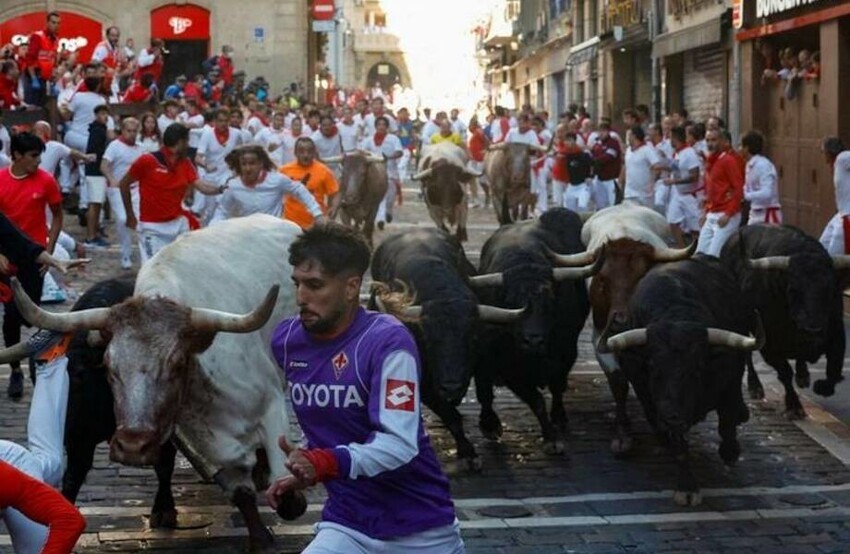
Источник:
Каждый июль в Памплону съезжаются более миллиона человек, чтобы поучаствовать в одном из самых ярких испанских фестивалей под названием Сан-Фермин. Он длится целую неделю, люди тут гуляют, веселятся, смотрят корриду и… убегают от разъяренных быков. Предлагаем посмотреть, какой яркой была прошлая неделя в Памплоне.
Открытие праздника всегда бывает 6 июля, а его закрытие — в полночь 14 июля
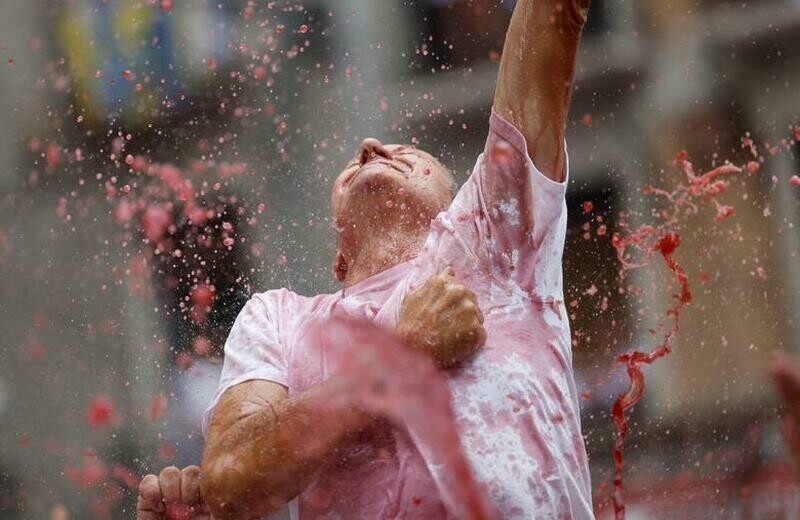
Источник:
Он посвящен святому Фермину, покровителю Наварры
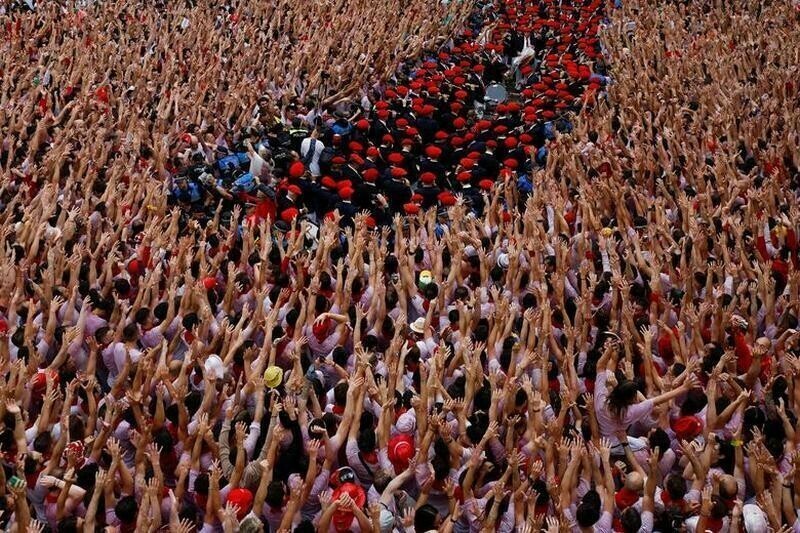
Источник:
Проводится праздник уже более восьми столетий, и неизменно в нем одно…
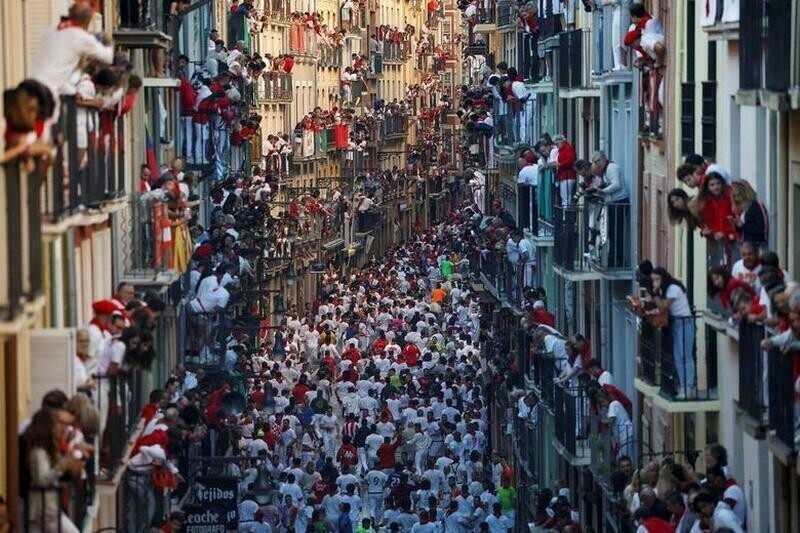
Источник:
Это семь дней круглосуточного веселья, гулянка, шествие гигантских кукол, уличные представления
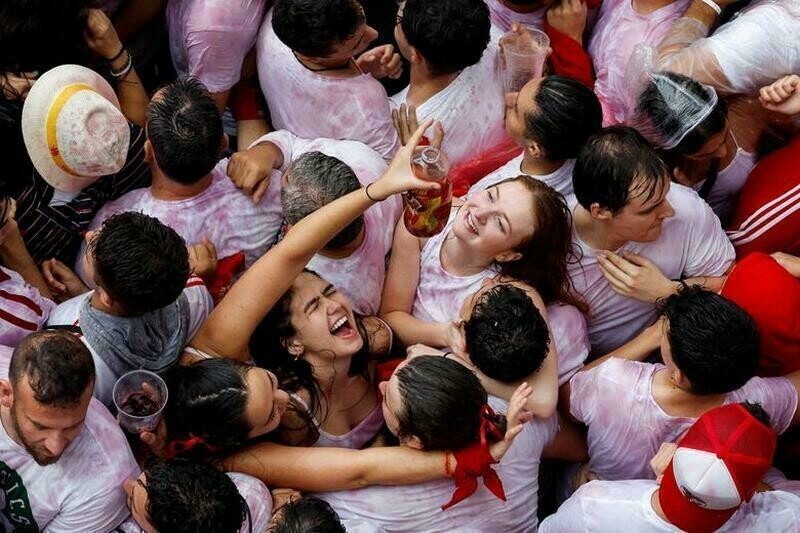
Источник:
Особое место занимает коррида, и каждое утро на арену разъяренных быков гонят по улице
Источник:
А перед быками бегут горожане и туристы, спасаясь от раздраженных животных
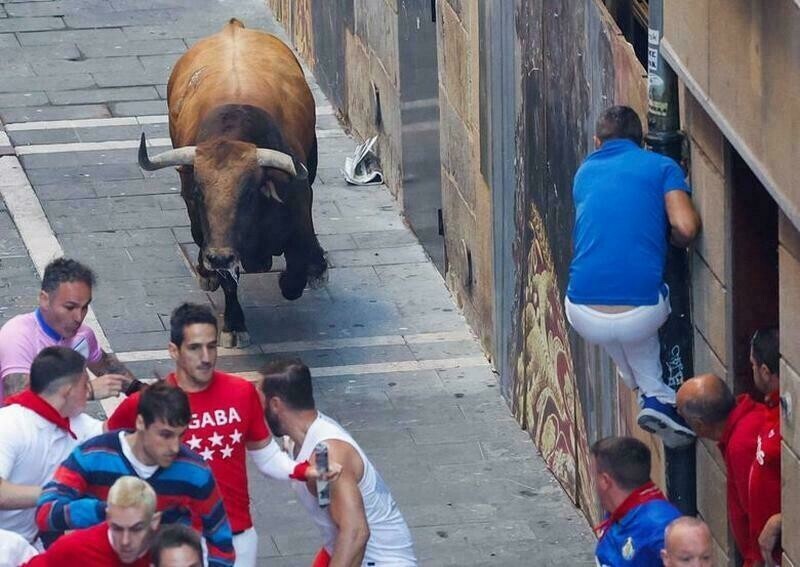
Источник:
Этот побег от быков получил название «энсьерро»
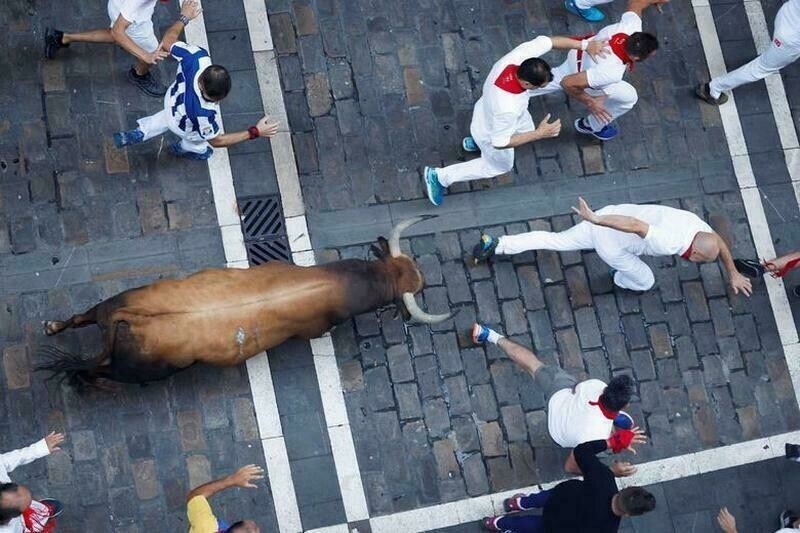
Источник:
Длится мероприятие около пятнадцати минут, но оно самое зрелищное на фестивале
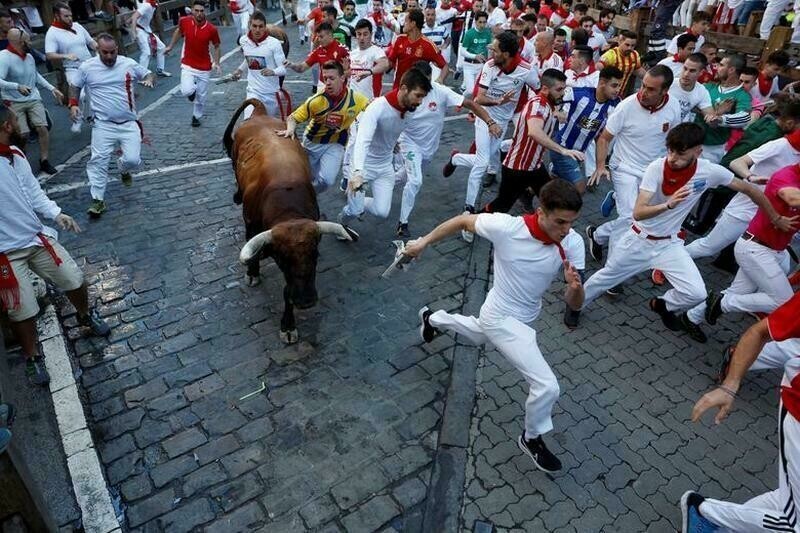
Источник:
Непонятно, как горожане решили бегать перед быками, известно, что в XVIII веке традиция уже существовала
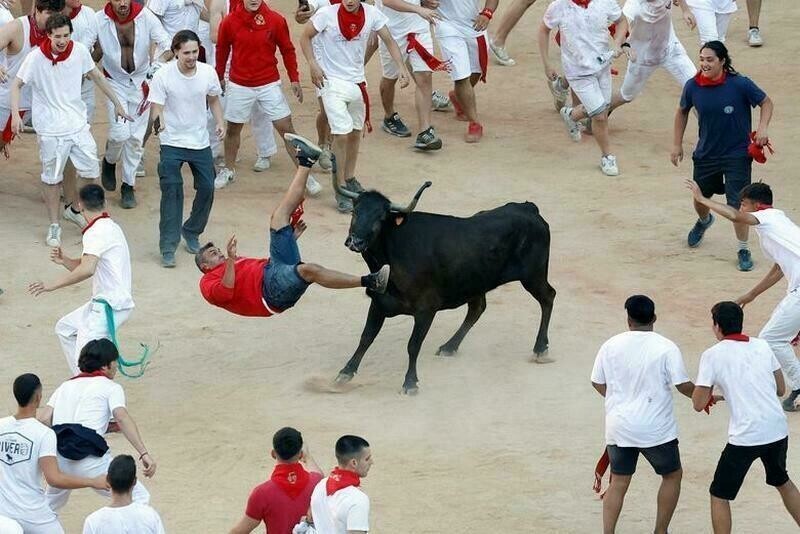
Источник:
В Памплоне есть легенда, что святой Фермин встретил именно таким образом свою смерть
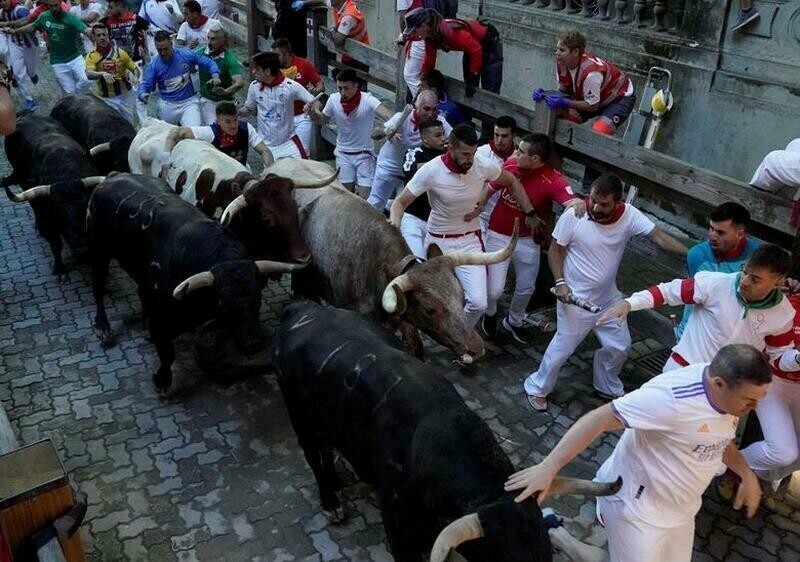
Источник:
Мученика, который проповедовал христианство, волокли по улице, а за ним гнались быки
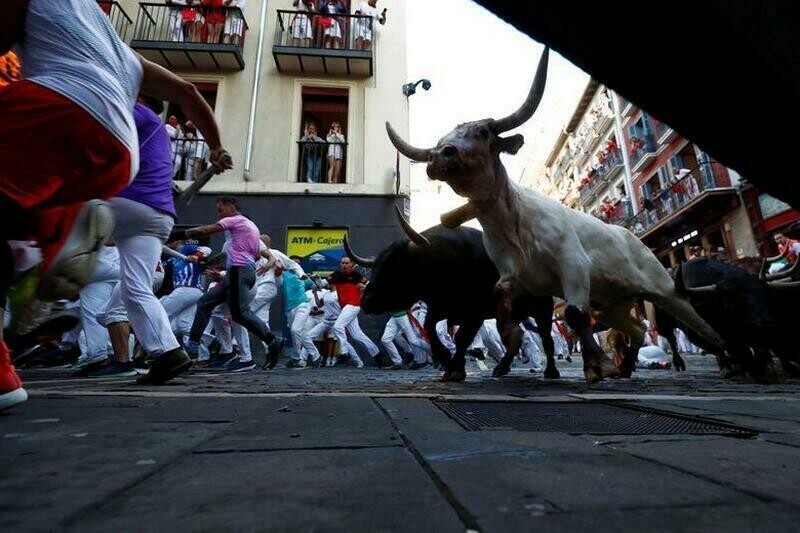
Источник:
Так что каждое утро фестиваля десятки людей выходят перед быками, чтобы повторить забег
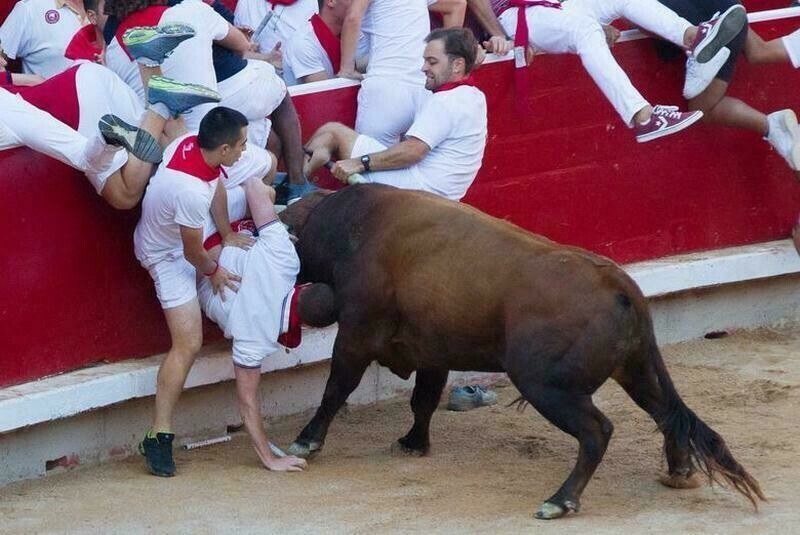
Источник:
Бегут они по узким улочкам в общей сложности чуть более 800 метров
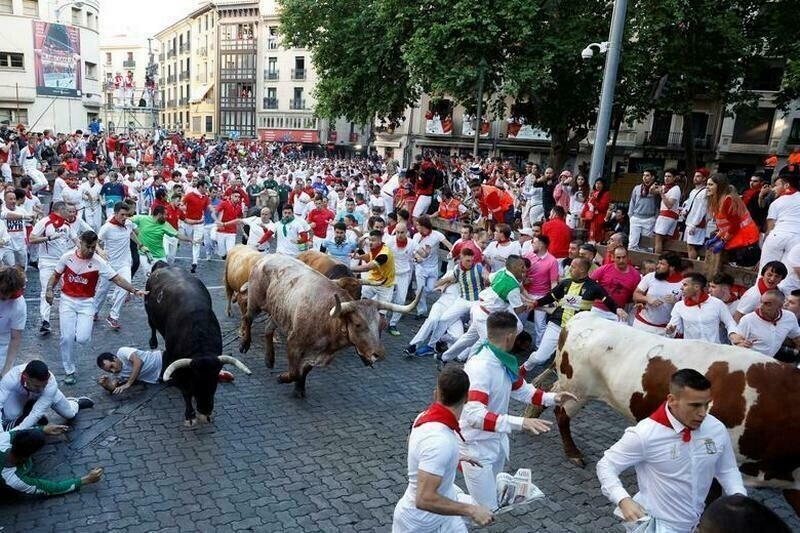
Источник:
Но это все равно очень зрелищно и очень опасно
Источник:
Конечно, не обходится без травм и ушибов, за неделю к медикам обращаются около 300 гостей
Источник:
Редко травмы бывают несовместимы с жизнью (последний случай был в 2009 г.)

Источник:
Однако это не мешает каждое утро начинать с энсьерро, самой зрелищной части праздника
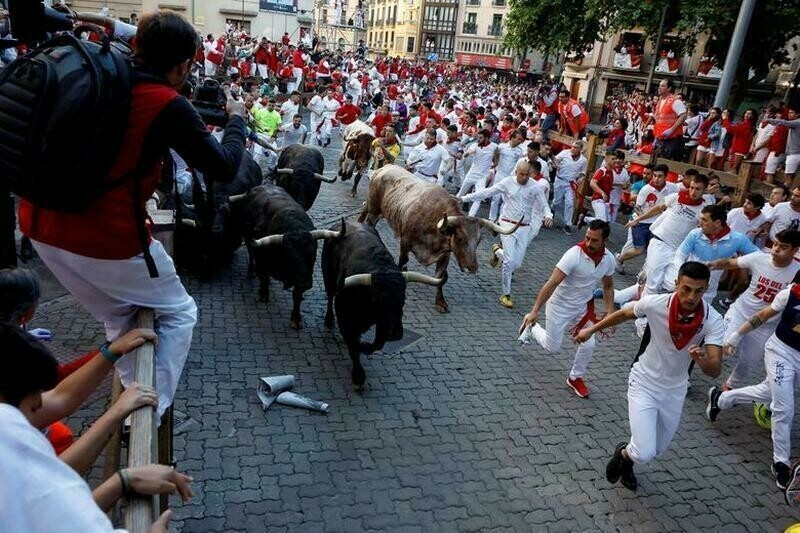
Источник:
Источник:
Ссылки по теме:
Новости партнёров
реклама


